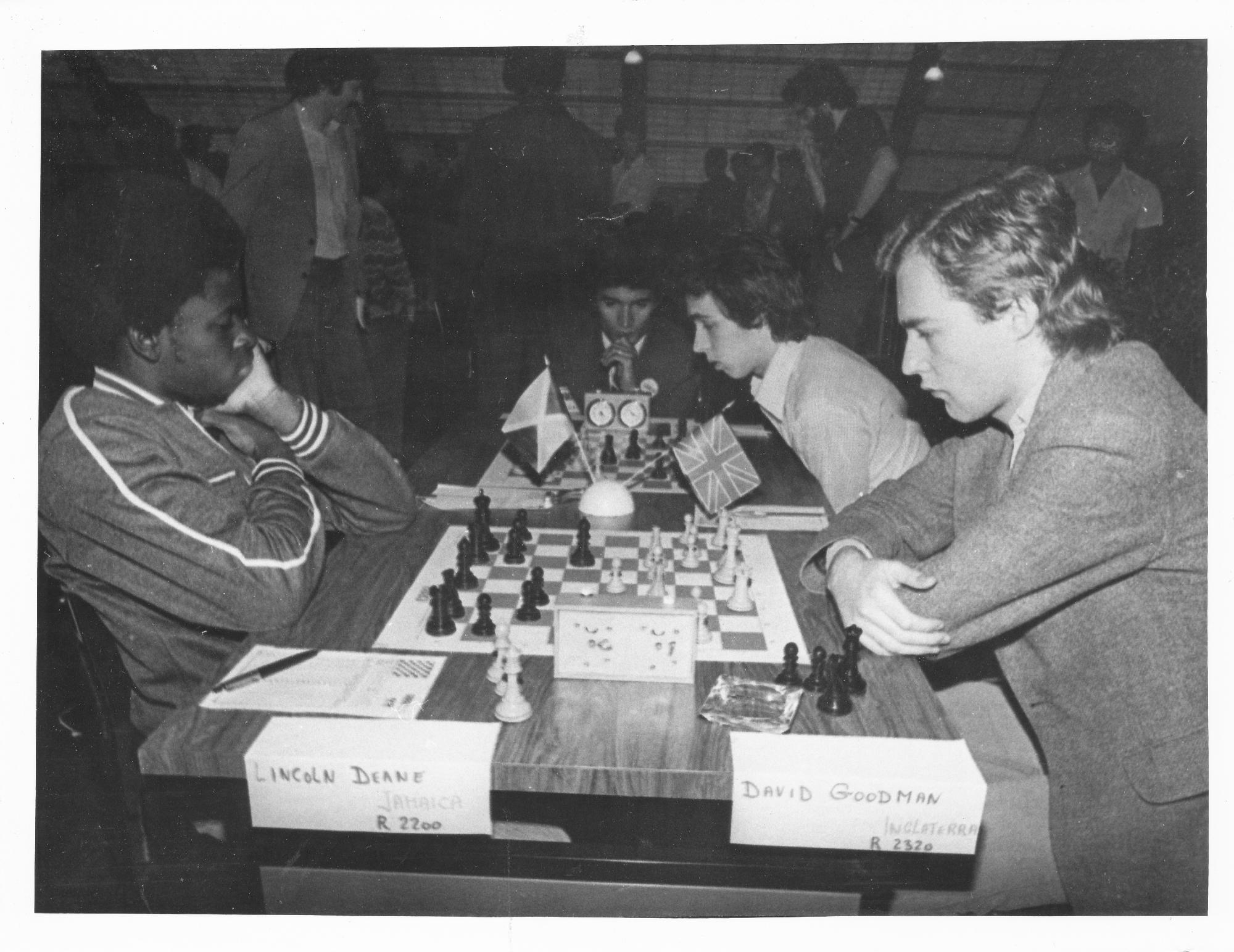Birthday of IM Peter Thomas Roberson (22-iii-1989)
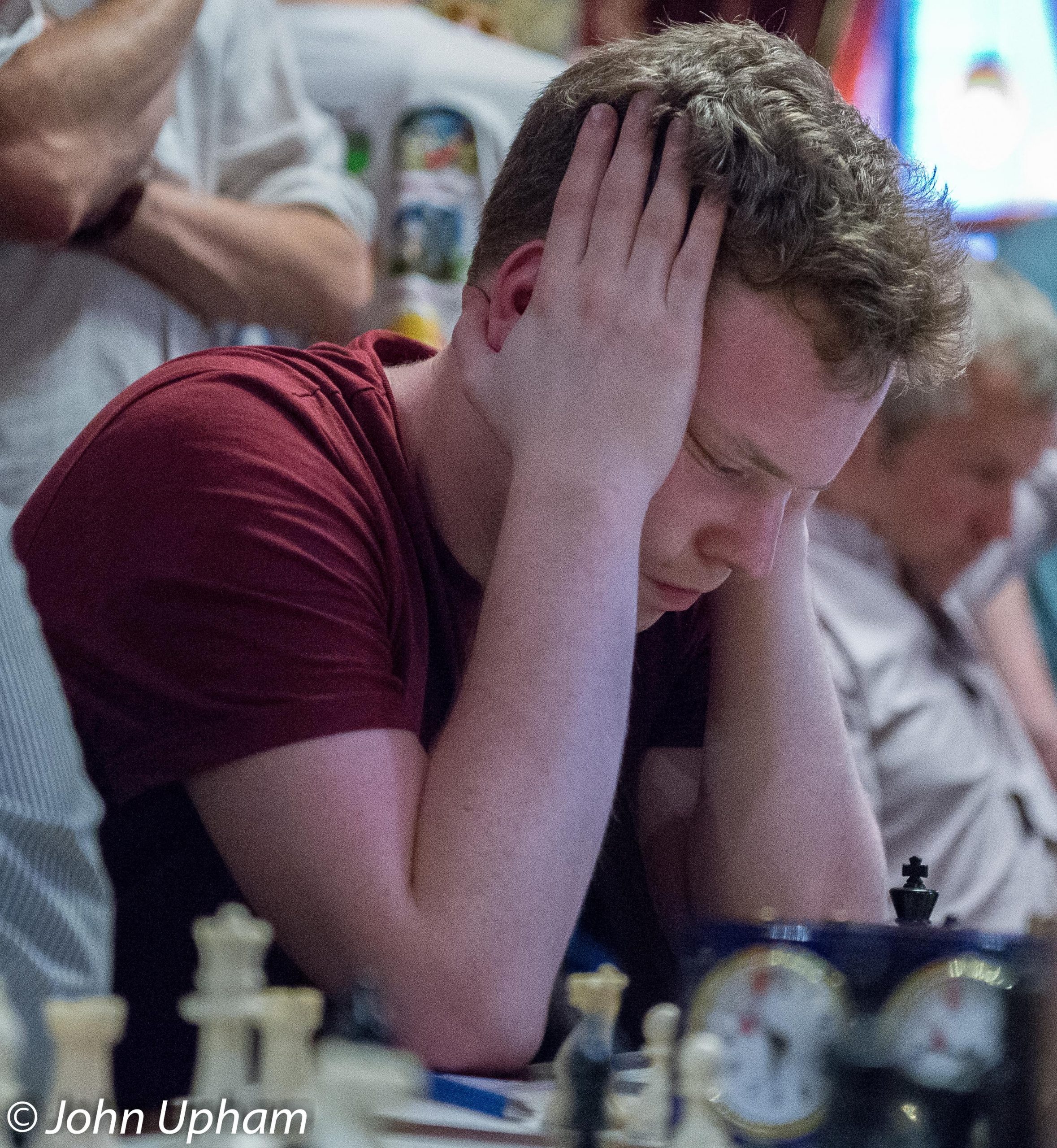
Peter is IM Squirlolz on chess.com
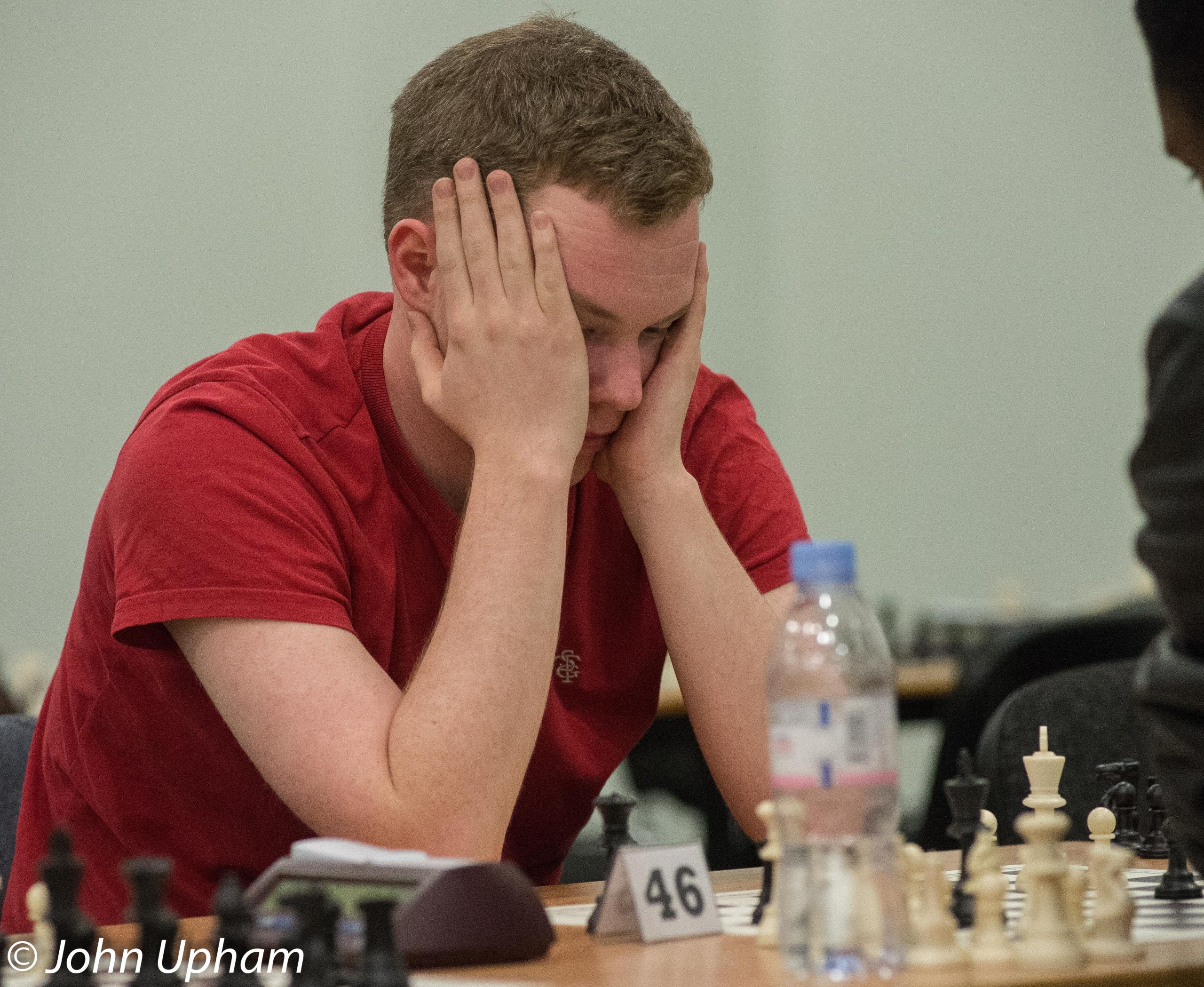
Peter’s games from chessgames.com
Birthday of IM Peter Thomas Roberson (22-iii-1989)

Peter is IM Squirlolz on chess.com

Peter’s games from chessgames.com
BCN remembers Gerald Abrahams who passed away in Liverpool on Saturday, March 15th 1980. He was buried in the Allerton Cemetery in the Jewish Springwood plot.
Gerald Abrahams was born in Liverpool on Monday, April 15th 1907. On this day the Triangle Fraternity was formed at the University of Illinois at Urbana–Champaign.
His parents were Harry (b. 10th September 1880) and Leah (b. 12th March 1884) Abrahams (née Rabinowitz) who married in West Derby in the third quarter of 1903.
Gerald learnt chess at the age of ten during the first world war. He obtained an Open Scholarship to Wadham College, Oxford in 1925 reading PPE and earning himself an MA in Law in 1928. He became a practising barrister at Law.
From the 1939 register we learnt that Harry was a Drapery manufacturer and Leah carried out “unpaid domestic duties”. Gerald was not an only child: the first born was Winnie (b. 22nd November 1903) who was a Secretary and Clerk Typist and factory assistant. Elsie Abrahams (b. 14th April 1905) helped her mother with “unpaid domestic duties”. Blanche was Gerald’s older sister and she was “General Assistant In Fathers Business Drapery Manufacturer”. Gerald is listed (aged 32) as a Barrister at Law and author. The family resided at 51 Prince Alfred Road, Liverpool, Lancashire (now L15 6TQ) and their original property has been since replaced.

We learn from “Philanthropy, Consensus, and broiges: managing a Jewish Community A history of the Southport Jewish Community
by John Cowell” of an incident in January 1942 that was to cause ripples in the community. The headline was
POLICE RAID DISTURBS CLUB CARD PLAYERS
The full list of people present seems to have been largely or entirely Jewish in religion or ethnicity: it included a famous chess-playing barrister from Liverpool, Gerald Abrahams, representing himself, who had taken a First in P.P.E. at Oxford, and later married Elsie Krengel, who had also been present, and with Leslie Black representing the rest of the defendants, apart from the hosts and Captain Lionel Husdan, who sent a letter to the court.
The full list of those present, charged with “resorting and playing in a common gaming house,” and bound over was as follows:- Mott Alexander, Fannie Finn, Maxwell Glassman, Kate Lippa, Myer Lister, Gertrude Mannheim, Joseph Mannheim, Rita Mannheim, Simon Mannheim, Harry Peters, Sadie Peters, Lily Leah Ross, Harry Sapiro, Benjamin Stone. Those charged with “resorting in a common gaming house” and bound over, were:- Gerald Abrahams, Joseph Appleton Bach, Samuel Myer Barnett, Herbert Solomon Isaacson, Elsie Krengel, Manuel Mannheim, Louis Michaelson, Abraham Ross, Bernard and Elsie Ross.
“Gerald Abrahams, the barrister charged, said he was interested to protect his reputation from being stigmatised by a conviction, and asked Sergeant Laycock about alcohol: the latter replied that none was being consumed. He submitted that the club was not a gaming house, and that draw poker had not been proved other than as a game of skill. Charges were dismissed against Henry, Eva and Marjorie Black, Myer Waldman, and Captain Lionel Husdan, of Ryde, Isle of Wight, all of whom had said that they were merely taking refreshments in the club, and had not played. David Platt said that he had not the slightest idea that they were breaking the law, and Mrs Platt said that it had not been a paying venture.”
The Complete Chess Addict (Faber& Faber, 1987), Fox & James notes: that Gerald Abrahams as authority on bridge cast doubt on assertions that Emanuel Lasker “was good enough to represent Germany”
Gerald’s comparisons of chess and bridge are discussed by Edward Winter in Chess Facts and Fables (McFarland, 2005) page 130 in GAs 1962 book Brains in Bridge:
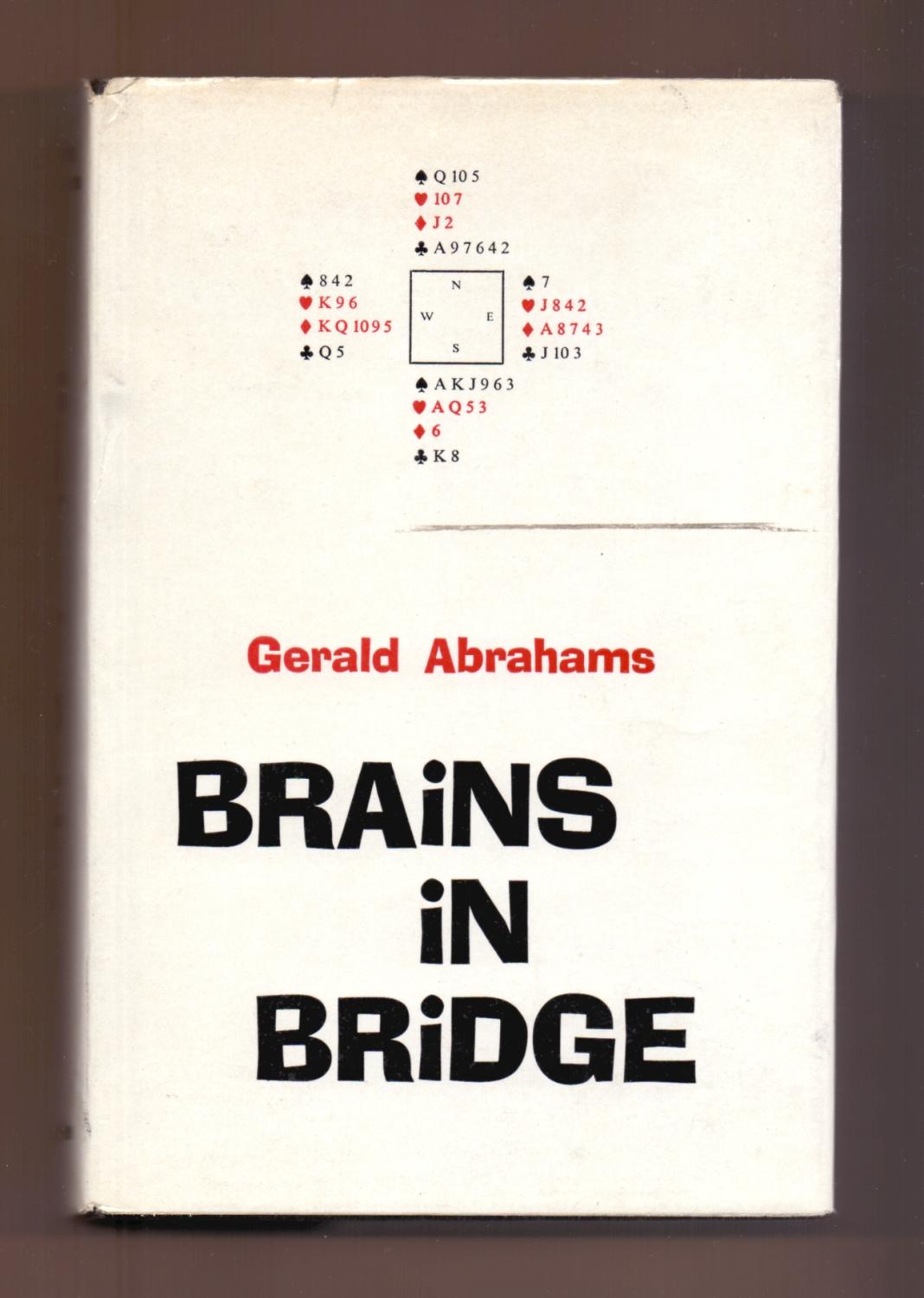
Gerald eventually married Elsie Krengel (born 15th January 1909) in the fourth quarter of 1971 in Liverpool at the age of 64. Elsie had lived in the Southport area for most of her life and her family was associated with the manufacture of handbags. They had known each other for many years (at least since 1942 as mentioned previously).

Leonard Barden modestly recounts :
“At the end of Nottingham 1954 Gerald claimed that Alan Phillips had accepted his draw offer so tieing Gerald for the British championship with some rabbit whose name escapes me. When Phillips strongly denied having accepted the draw, Gerald collapsed on the floor and had to be aided by his old enemy Dr. Fazekas.”
From The Anglo-Soviet Radio Chess Match (1946) by Klein and Winter:
“G. Abrahams was born in Liverpool in 1907. He learned chess at the age of ten, and showed an early aptitude for tactical complications. He has played with varying success, his best performances being third and fourth with Rossolimo, behind Klein and Najdorf, but head of List at Margate, 1938, and fourth, fifth and sixth with Sir George A. Thomas and König in London, 1946. He has made two valiant bids for the British Championship.
A graduate of Oxford, he is a barrister by profession and has written several books, including some fiction. He has solidified his chess without allowing it to become dry. Indeed, most of his games sparkle with interesting complications.”
Harry Golombek OBE wrote (in The Encyclopaedia of Chess (Batsford, 1977)):
“Brilliant British amateur who in the 1930s was playing master-chess. In that period he was the most dangerous attacking player in England.
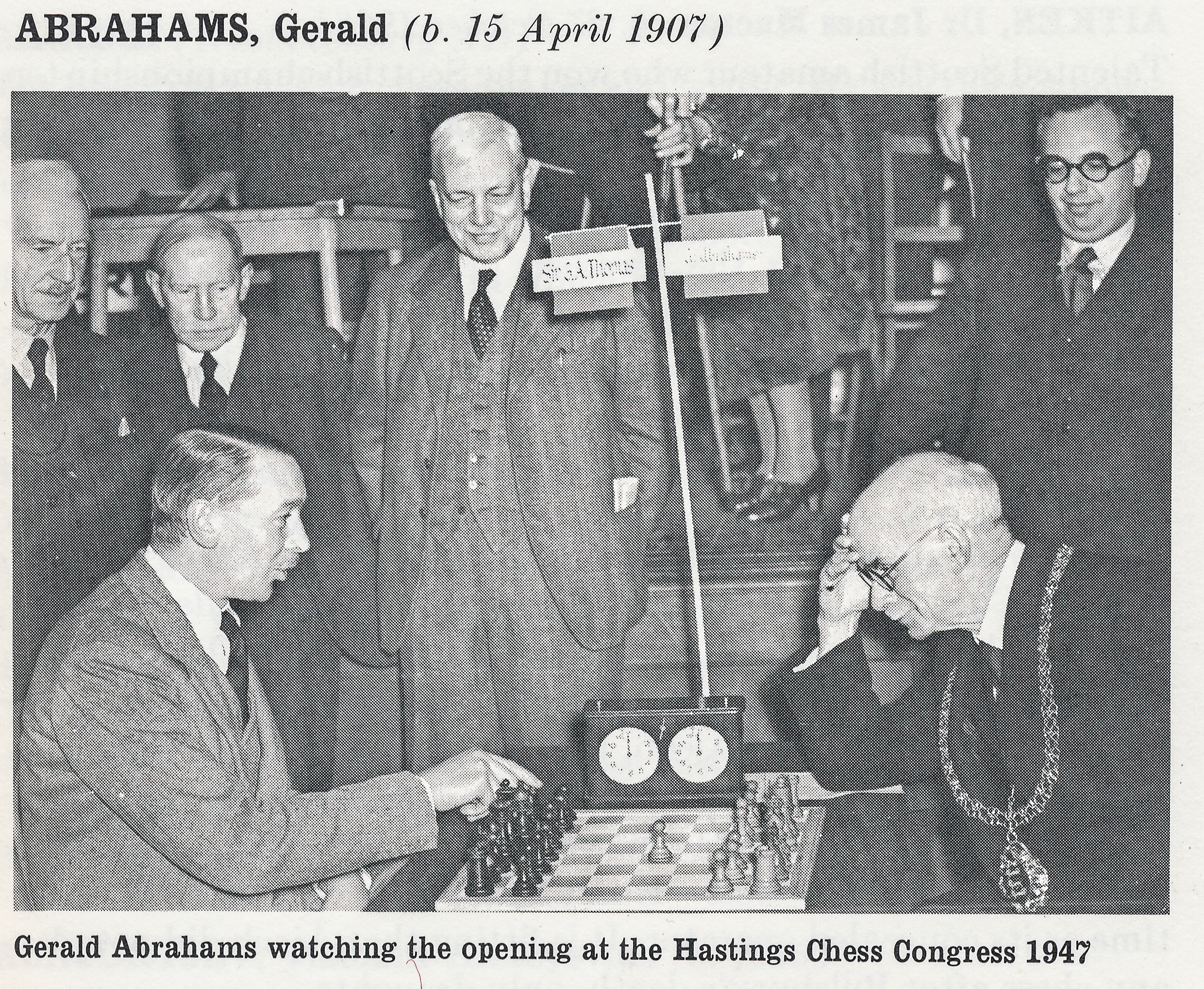
He was in the prize-list (i.e. in the first four) in the British championship on three occasions 1933, 1946 and 1954. His best international performance was in the Major Open at Nottingham in 1936 where he came =3rd with Opocensky. Another fine result was his score of 1.5-0.5 against the Soviet Grandmaster Ragozin, in the 1946 Anglo-Soviet radio match.
He is the inventor of the Abrahams variation in the Semi-Slav Defence to the Queen’s Gambit: 1.P-Q4, P-Q4;2.P-QB4, P-QB3;3.N-QB3, P-K3;4.N-B3, PXP;5.P-QR4, B-N4;6.P-K3,P-QN4;7.B-Q2, P-QR4; 8.PxP, BxN;9.BxB,PxP;10.P-QN3,B-N2;
This is sometimes known as the Noteboom variation after the Dutch master who played it in the 1930s, but Abrahams was playing it in 1925 long before Noteboom.
He is a witty and prolific writer on many subjects: on law (he is a barrister by profession), philosophy, and chess; he also writes fiction. His main chess works are: The Chess Mind, London 1951 and 1960
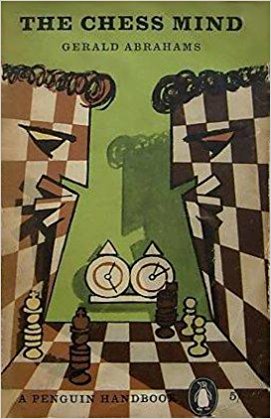
and here is a later cover:

and Not Only Chess, London 1974.
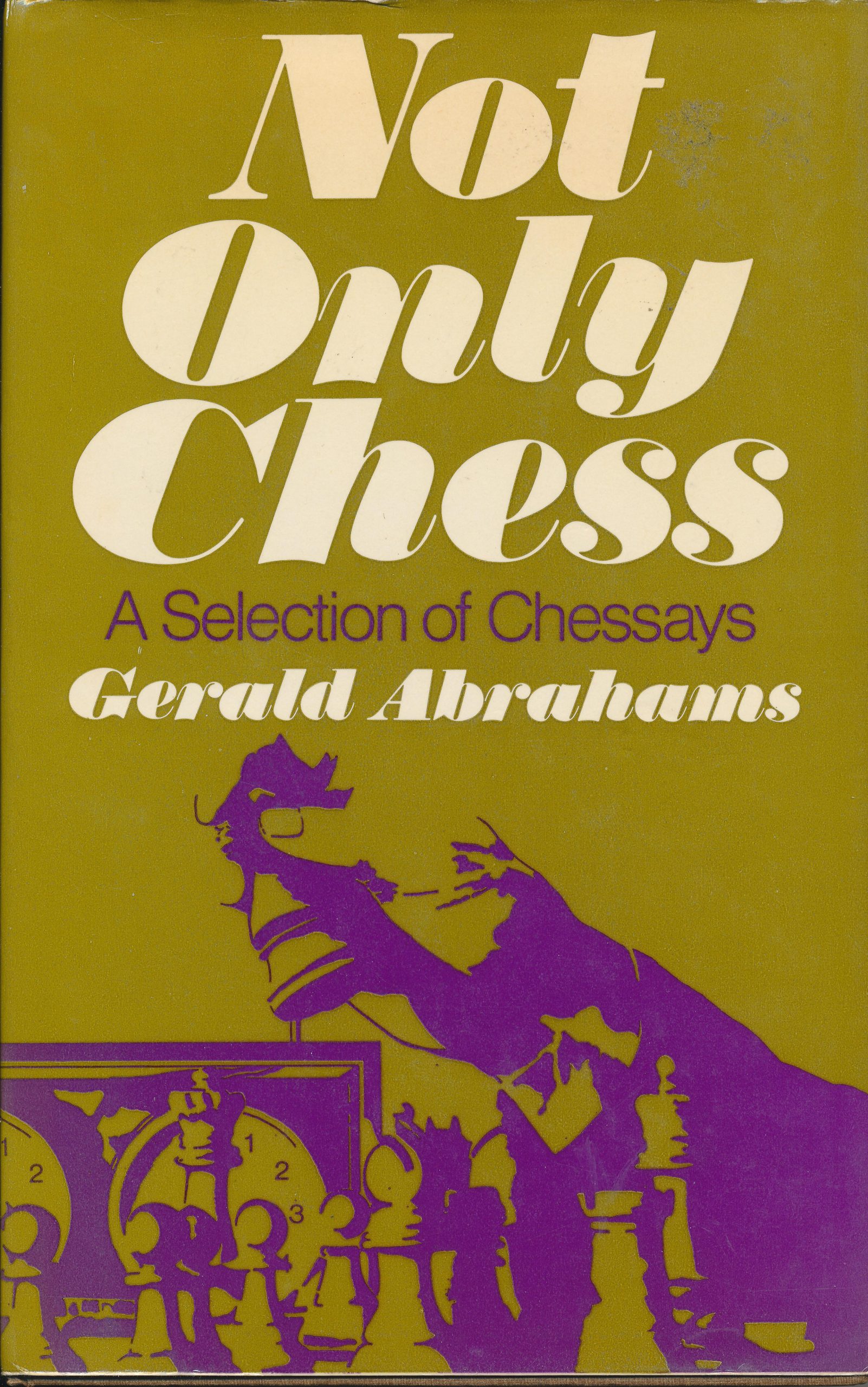
Edward Winter in Kings, Commoners and Knaves, cites the subtitle of the above book in his page 235 list of chessy words: “A selection of Chessays”.
From Not Only Chess we learn that GAs favourite game was played in 1930 against Edmund Spencer of Liverpool. “Edmund Spencer was a man who is remembered with affection by all players who ever met him, and who is remarkable in that his strength developed in what should have been hid middle life. When he died, lamentably early, in the 1930s, at about 53 he was at his best, and of recognised master status.
This game was played in 1930.”
and for an alternative view of the same game:
GA is amongst a rare breed of game annotators claiming the title of An Immortal for one of his own games. Edward Winter devotes a couple of column inches discussing exactly which year the game was played between 1929 and 1936. Here is the game:
For more of GAs excellent games see the superb article further on by Steve Cunliffe. Also, Not Only Chess in Chapter 28 (“A Score of my Scores”) contains a veritable feast of entertaining games of GAs).
Gerald famously fell out with Anne Sunnucks when he discovered she had omitted him from her 1970 Encyclopaedia of Chess. Despite this the 1976 edition was also devoid of a mention.
From The Oxford Companion to Chess (OUP, 1984 & 1996), Hooper & Whyld:
“The English player Gerald Abrahams (1907-80) introduced the move when playing against Dr. Holmes in the Lancastrian County Championship in 1925 (ed: January 31st in fact) . Abrahams played the variation against his countryman William Winter (1898-1955) in 1929 and in the same year Winter played it against Noteboom, after whom it is sometimes named. (Dr, Holmes was the favourite pupil of Amos Burn and a leading ophthalmologist).
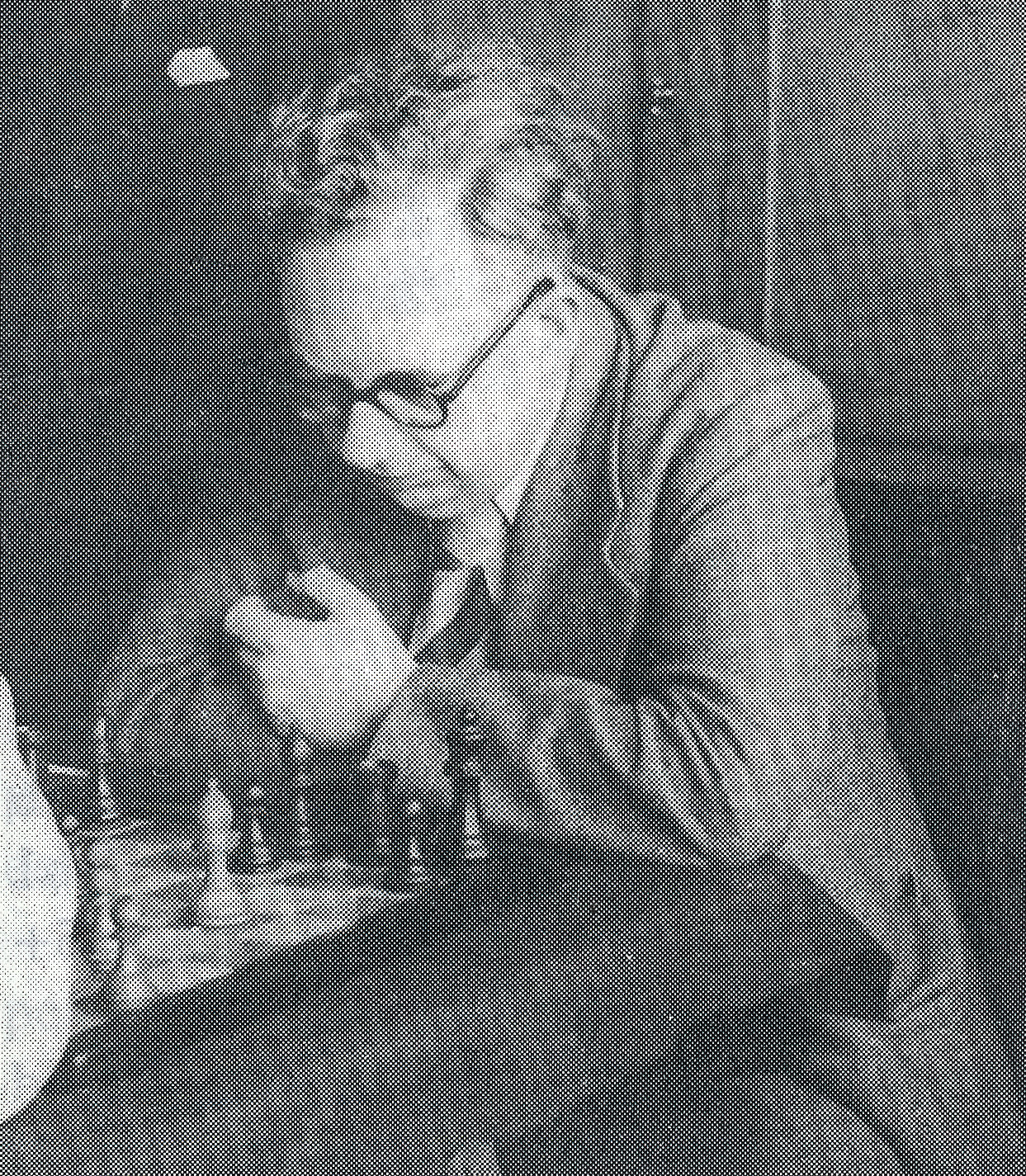
The precursor, known from a 16th-century manuscript, was published by Salvio in 1604:
1.d4 d5;2.c4 dxc4;3.e4 b5;4.a4 c6;5.axb5 cxb5;6.b3 b4;7.bxc4 a5; 8.Bf4 Nd7;9.Nf3
Writing in 1617, Carrera made his only criticism of Salvio’s analysis in this variation. He suggested 8…Bd7 instead of 8…Nd7, or 9.Qa4 instead of 9.Nf3. Salvio nursed his injured pride for seventeen years and then devoted a chapter of his book to a bitter attack on Carrera. The argument was pointless: all these variations give White a won game.”
GA famously wrote :
Chess is a good mistress, but a bad master
and also
The tactician knows what to do when there is something to do; whereas the strategian knows what to do when there is nothing to do.
and
In chess there is a world of intellectual values
and
Good positions don’t win games, good moves do
and
Why some persons are good at chess, and others bad at it, is more mysterious than anything on chess board.
In the recently (February 25th, 2020) published “Attacking with g2 – g4” by GM Dmitry Kryakvin writes about Abrahams as follows :
“It is believed that the extravagant 5.g2-g4 was first applied at a high level, namely in the British Championship by Gerald Abrahams. Abrahams was a truly versatile person – a composer, lawyer, historian, philosopher, politician (for 40 years a member of the Liberal Party) and the author of several books. Of his legal work, the most famous is the investigation into the murder of Julia Wallace in 1931 in Liverpool, where her husband was the main suspect. As an alibi, William Herbert Wallace claimed he was at a chess club. Dozens of books and films have been devote to the murder of Mrs. Wallace – indeed, this is a script worthy of Arthur Conan Doyle or Agatha Christie!

Abrahams played various card games with great pleasure and success, but the main passion of the Liverpool resident was chess. Abrahams achieved his greatest success in the championships of Great Britain in 1933 and 1946, when he won bronze medals. The peak of his career was undoubtedly his participation in the USSR-Great Britain radio match (1946) where on the 10th board Abrahams beat Botvinnik’s second and assistant grandmaster Viacheslav Ragozin with a score of 1.5-0.5
Gerald Abrahams had a taste of studying opening theory, and made a distinct contribution to the development of the Noteboom Variation, which is often known as the Abrahams-Noteboom.
Ten years after he introduced the move 5.g2-g4 to the English public (1953), the famous grandmaster Lajos Portisch brought it into the international arena.”
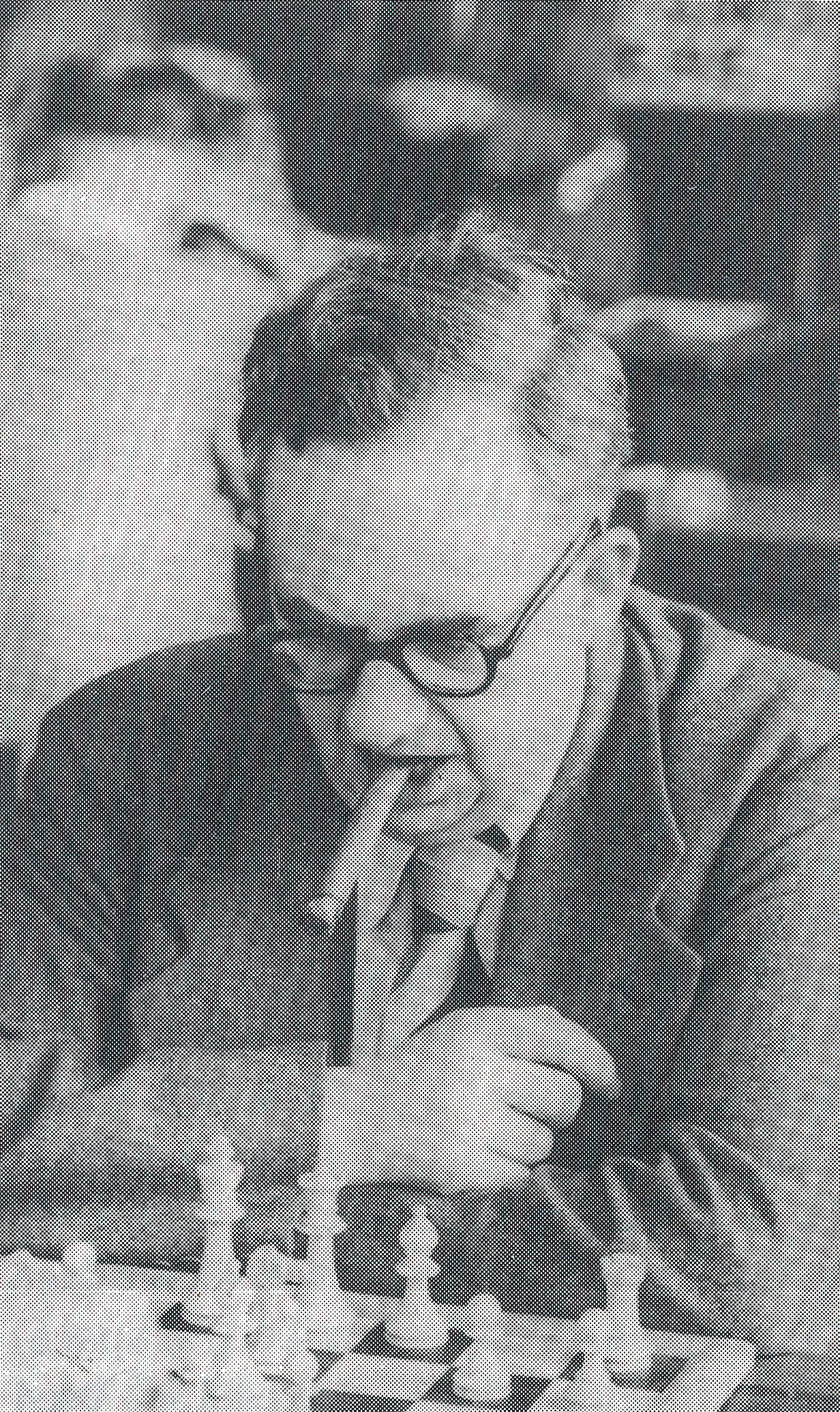
Gerald was also a keen studies composer. Here are some examples of his work:
Gerald Abrahams, 1923
1/2-1/2
Solution: 1. Ra3! Ra3 […a1=q;2.Ra1 Ba1;3.d7 Kf7;4.d8=q];2.e8=q a1=q;3.Qd7
and
Gerald Abrahams, 1924
1-0
Here is an interesting article by Tim Harding on the naming of the Abrahams-Noteboom Variation of the Semi-Slav Defence
Here is an article about GA and a blindfold exhibition
Gerald Abrahams contributed to opening theory in the Queen’s Gambit Declined / Semi-Slav Defence with his creation of the Abrahams-Noteboom Defence as discussed in the following video :
Here is a nine page article (Gerald Abrahams – Talent without Discipline) written by Steve Cunliffe that appeared in British Chess Magazine, Volume CVIII (1988), Number 7 (July), pp. 292-300:
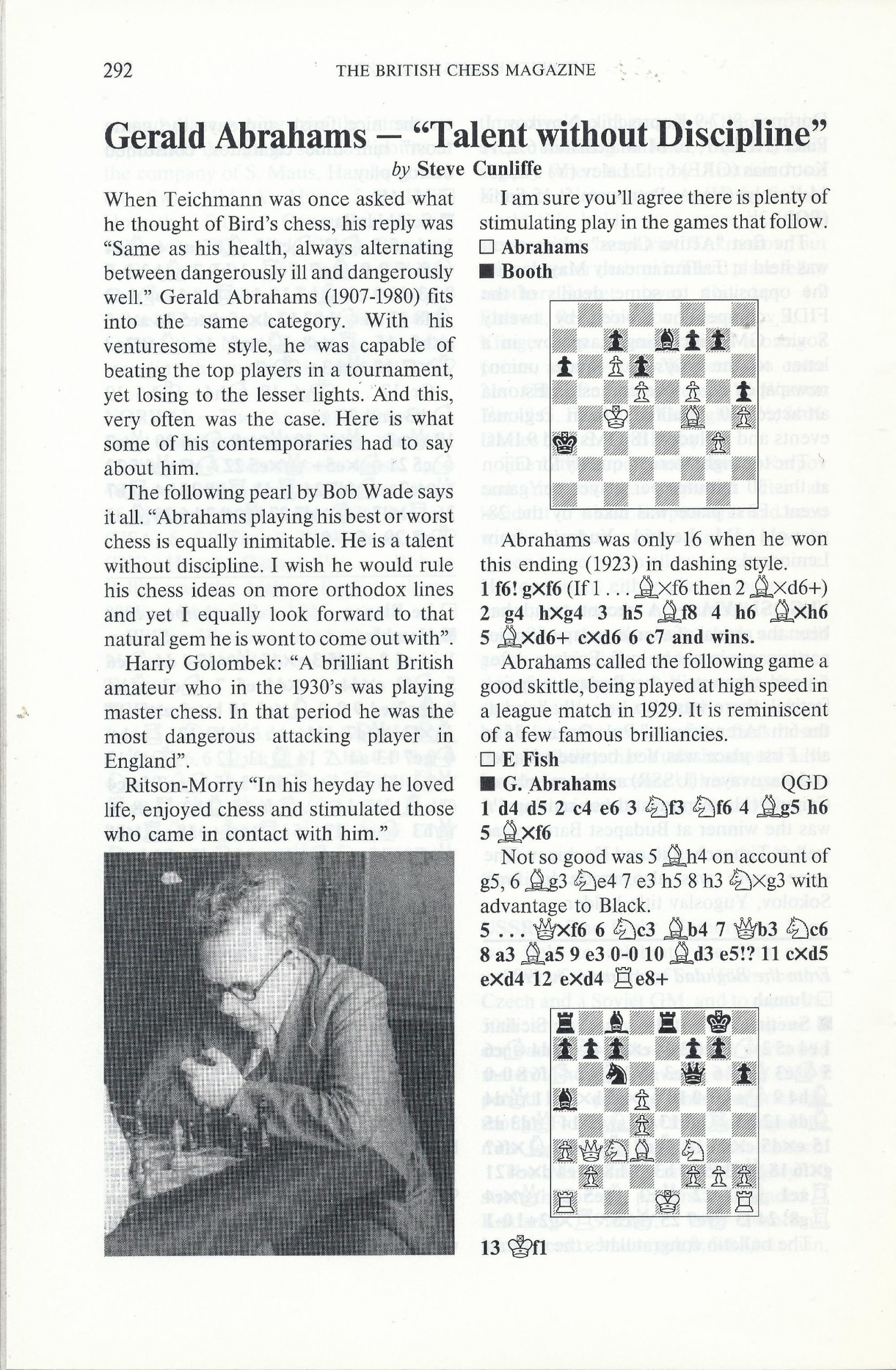

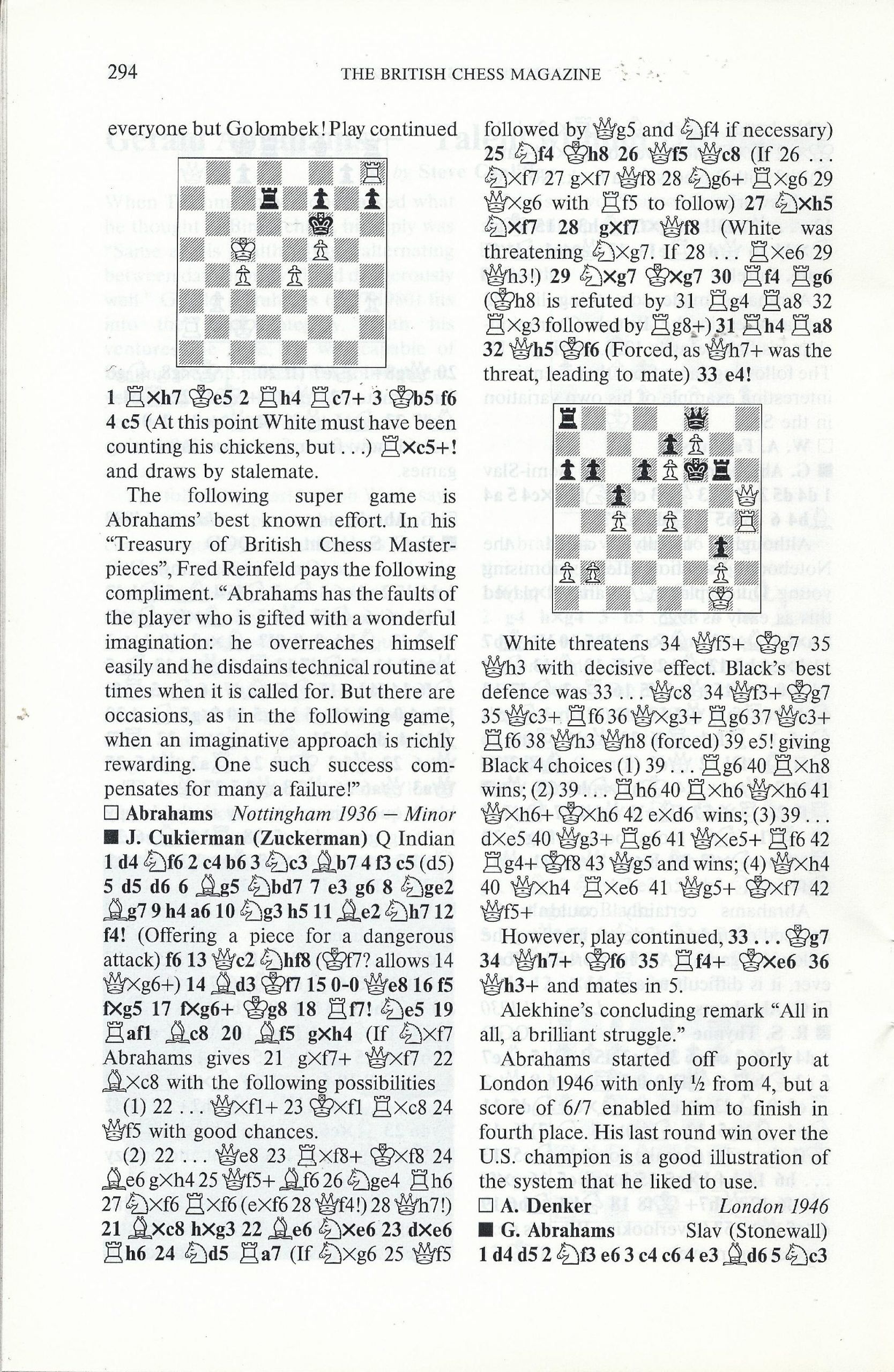
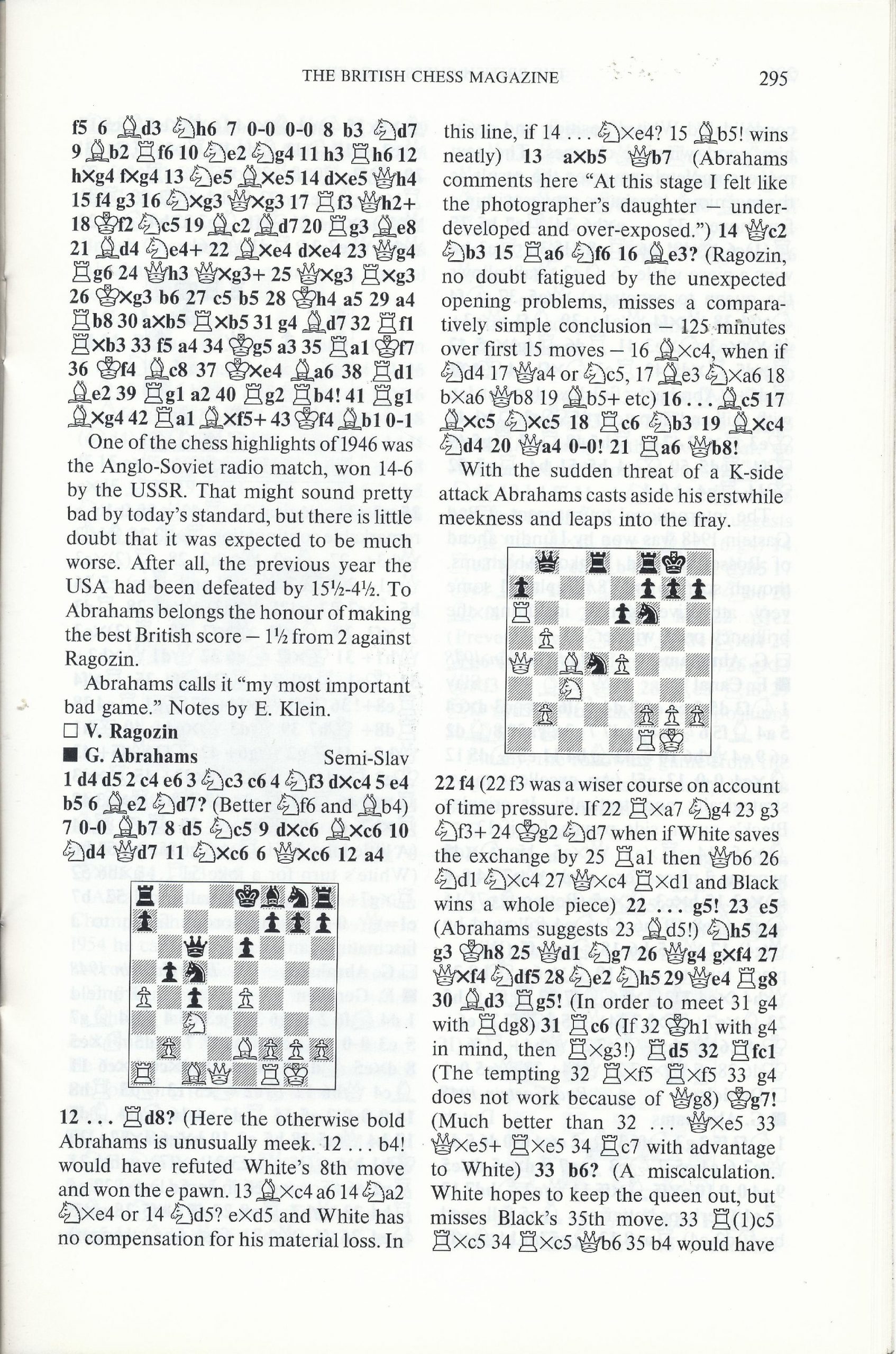
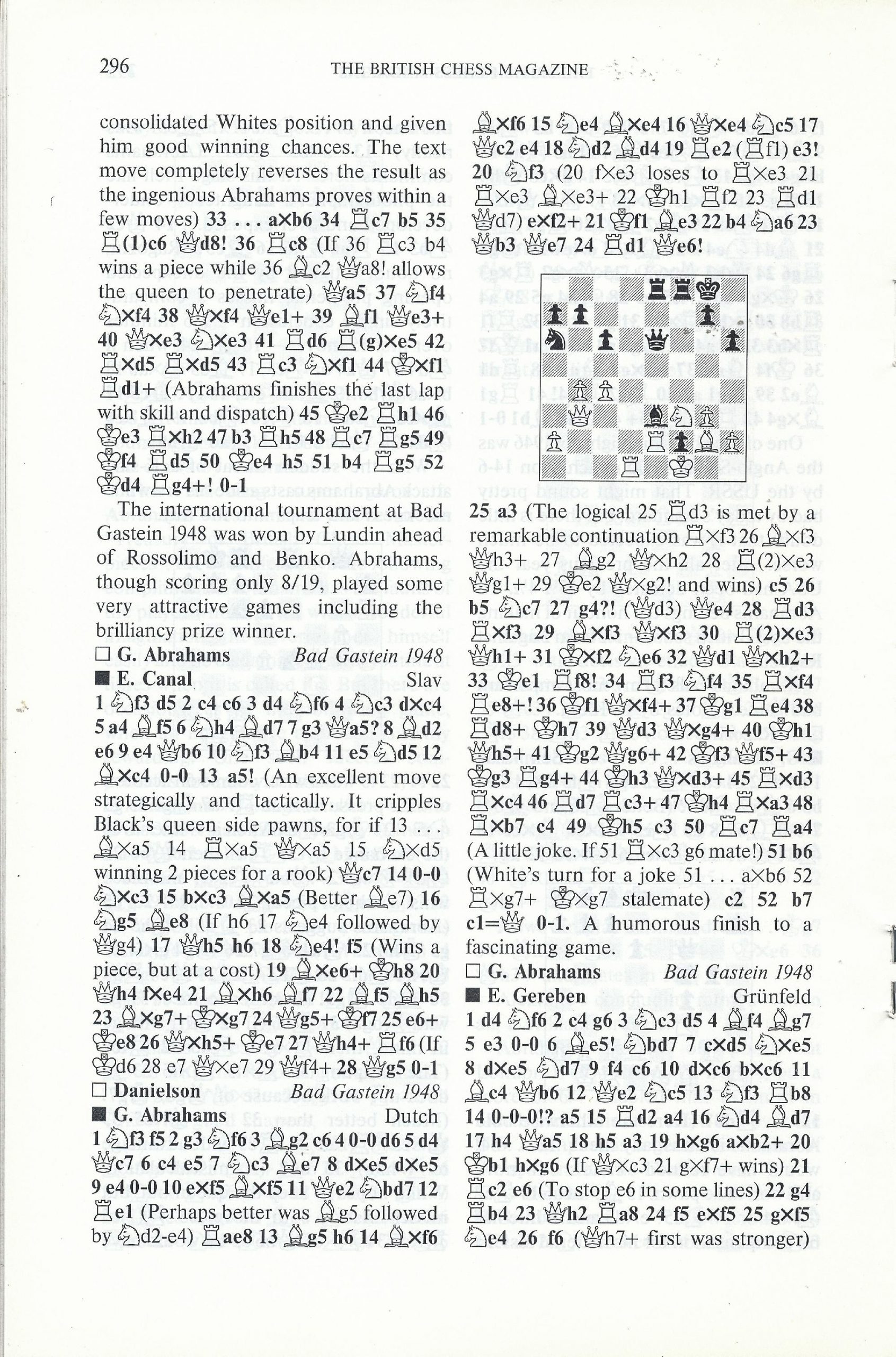
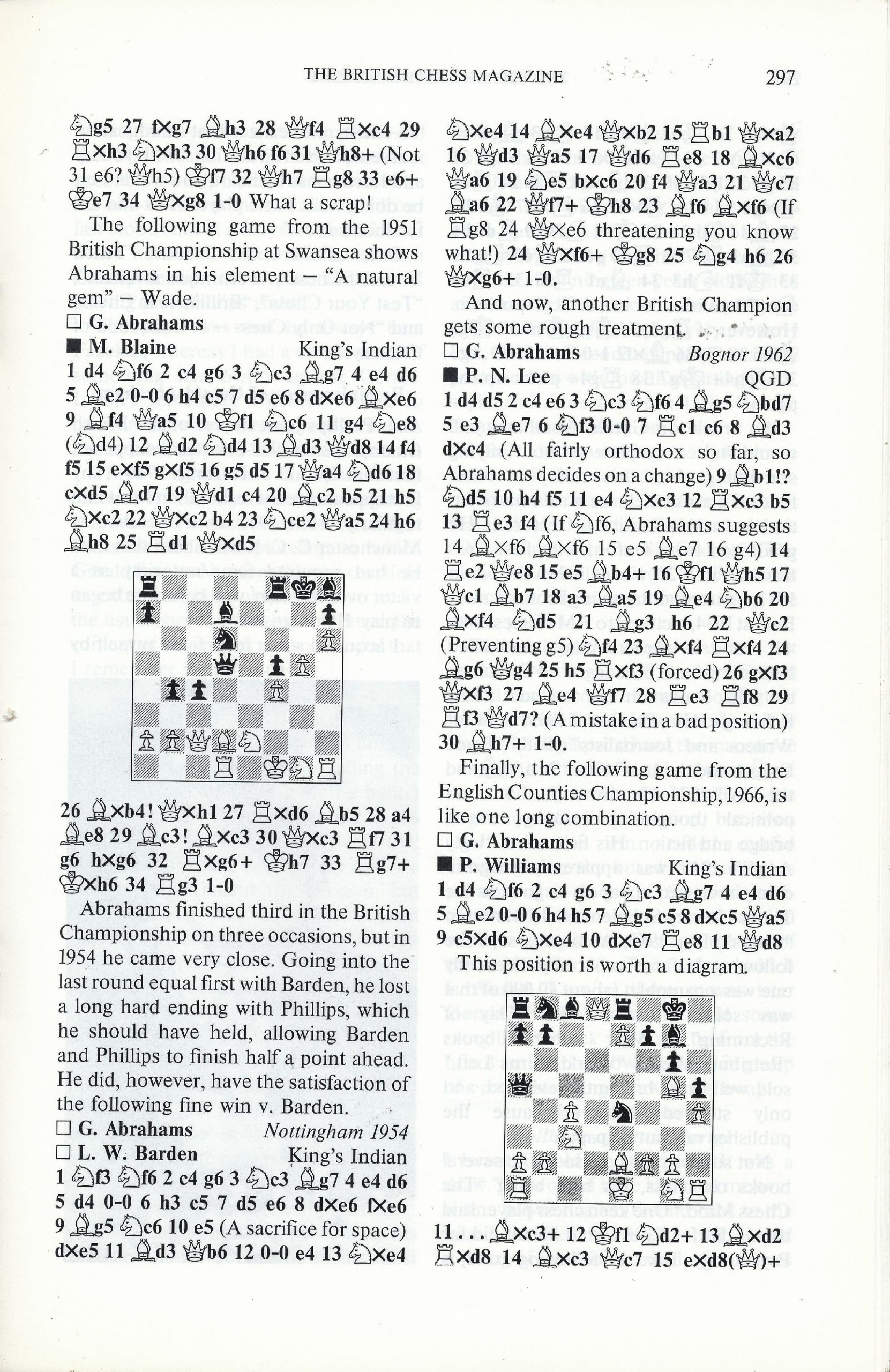
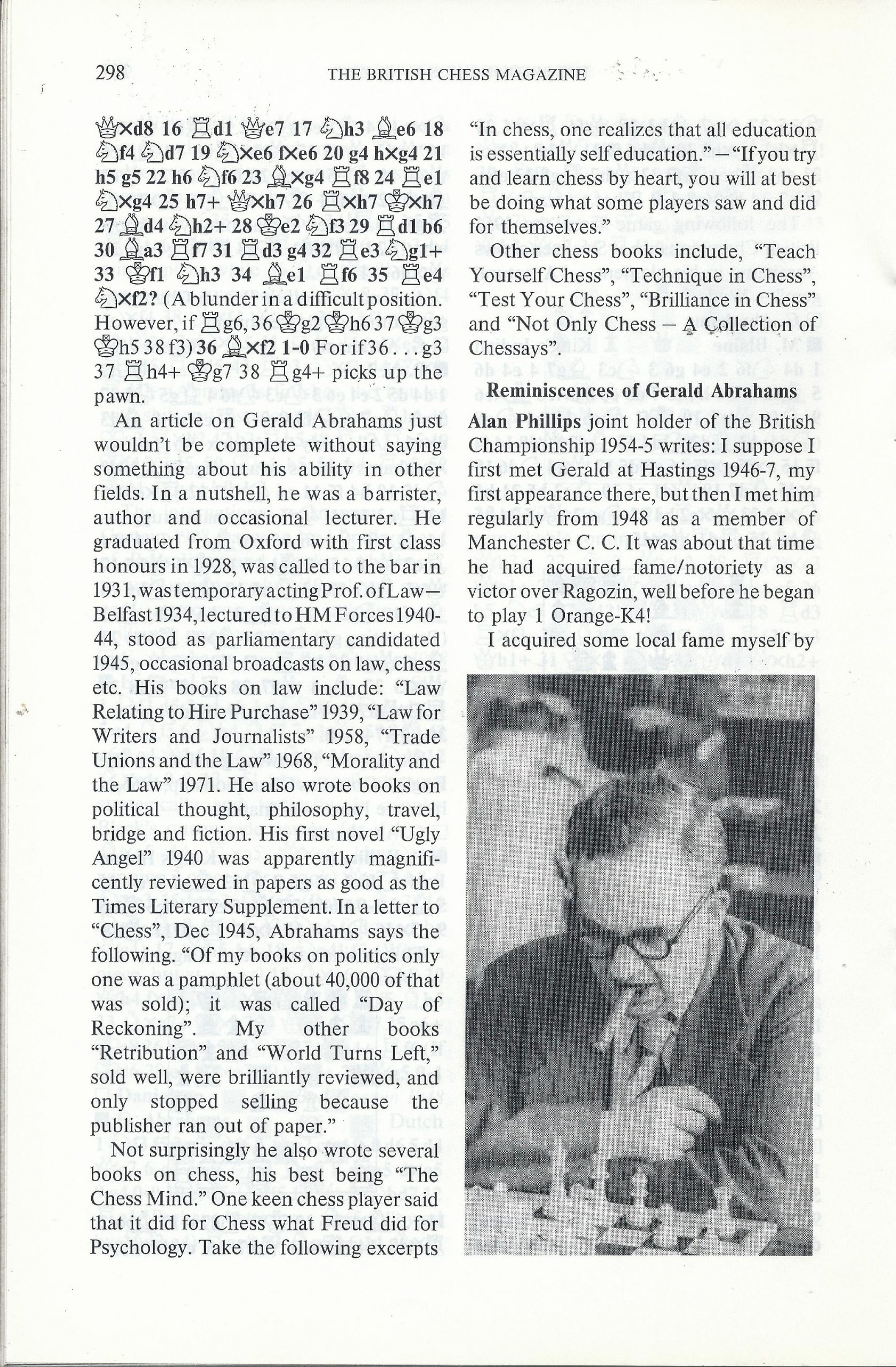
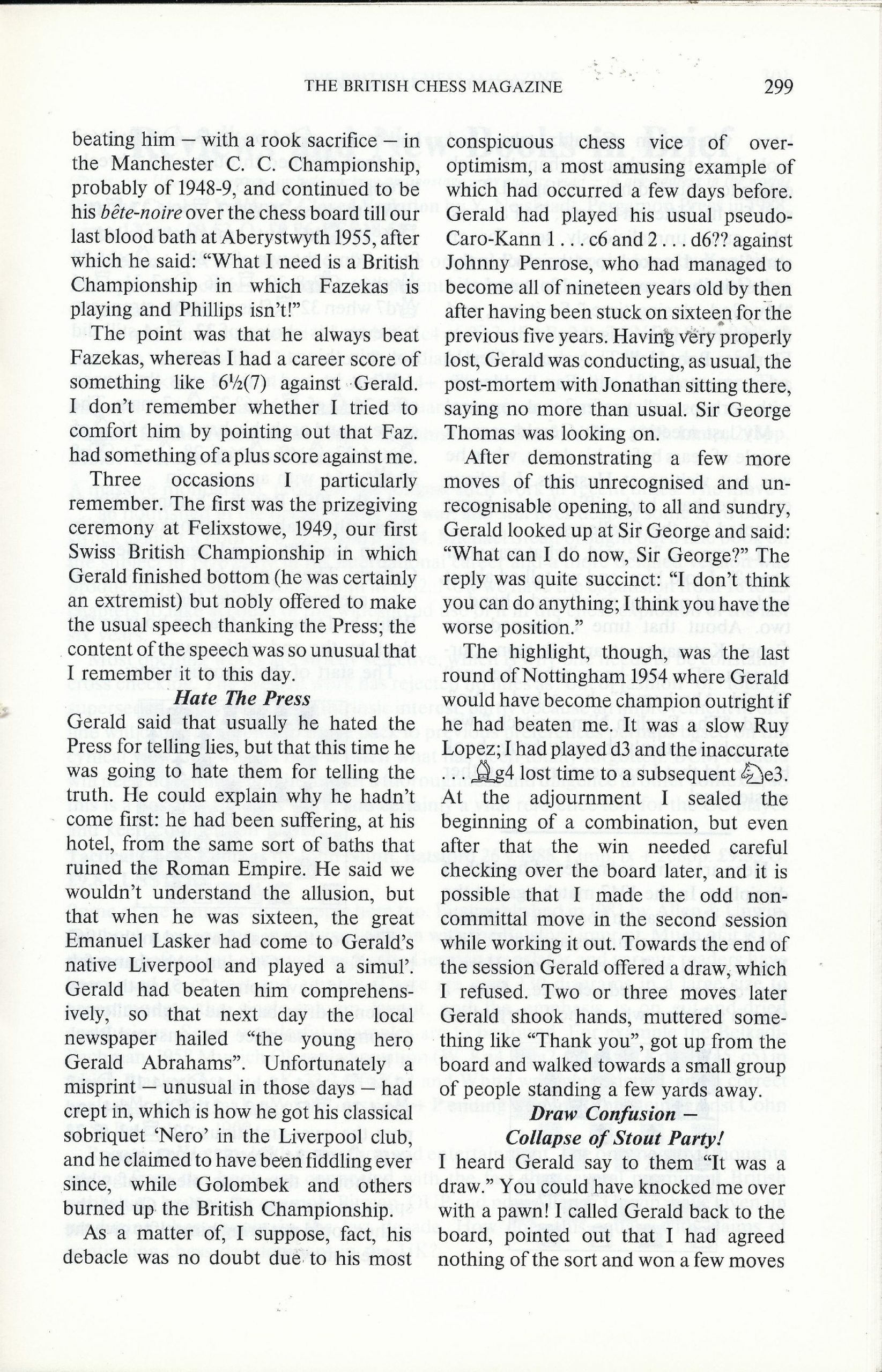
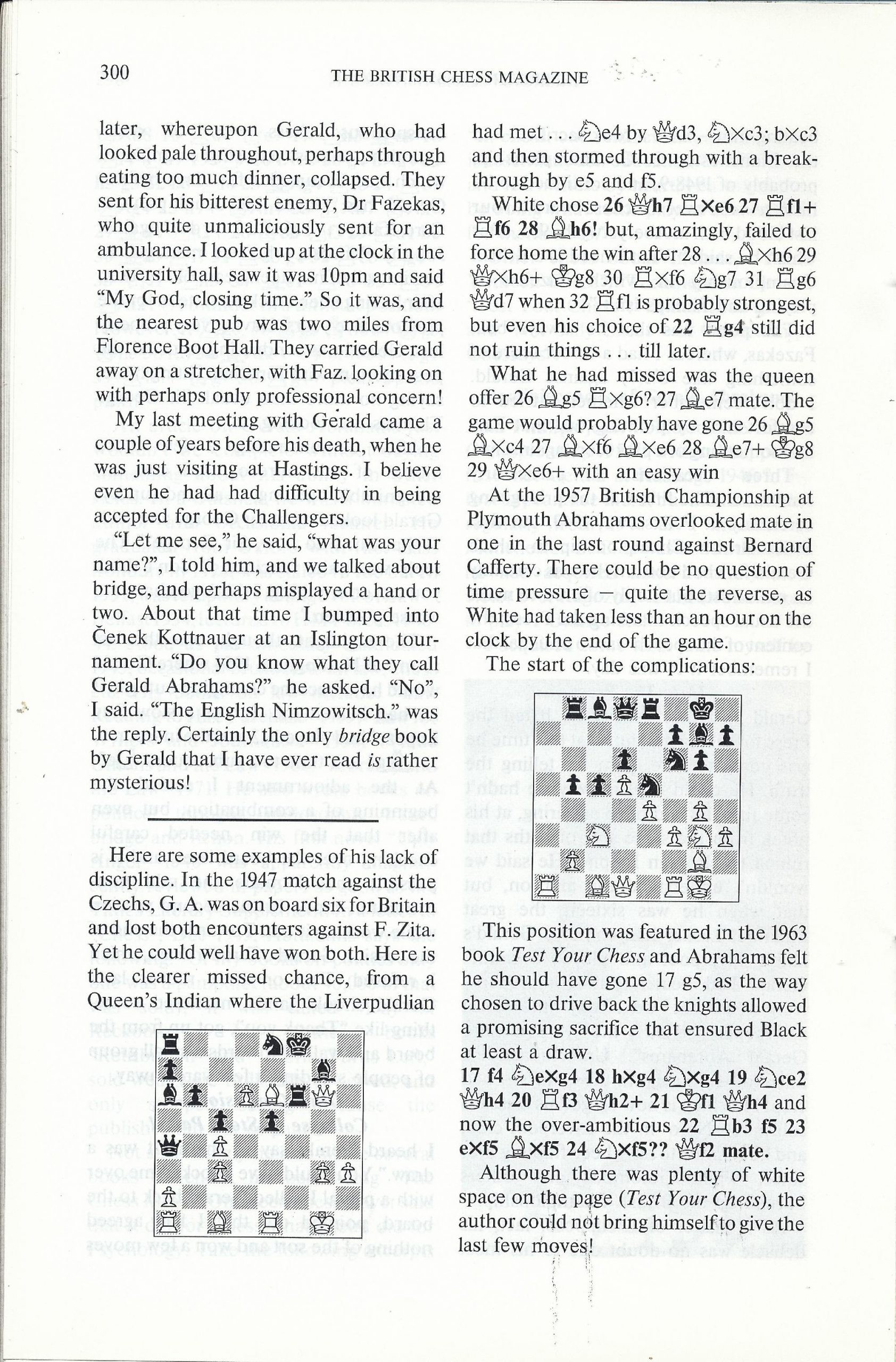
In the March issue of CHESS for 1963, (Volume 28, Number 427, pp.147-155) William Winter wrote this:
I cannot leave this group of players without reference to G. Abrahams, who, though less successful than the others, is much the most colourful of all both in play and personality. He is a player whom I would
always like to have on my side against the very best opposition, e.g. the Russians’ His unbounded optimism preclude any possibility of that consciousness of inferiority which infects nearly all our players when they come up against the very great and at his best he is capable of beating anyone.
It is true that his worst games are very bad indeed, but that does not matter. A loss is equally a loss after seventeen moves or seventy. I had a good deal to do with his selection for the Anglo-Soviet Radio match of 1946, and he thoroughly justified my confidence with a win and a draw against Ragosin, being the only English player to score
a majority. In the match over the board he failed, and was promptly dropped, a great mistake in my opinion. Abrahams is always capable of beating a grand master, the majority of English players are not.
A man of versatile talent, he is a successful barrister shining particularly on advocacy, an author of novels and essays as well as chess books, and he gave a striking example of his optimism standing as Liberal candidate for Parliament. I wish he had been elected. He would certainly have enlivened the house.
Of his chess books I must say a good word for Teach Yourself Chess. The title of course suggests an impossibility one cannot teach oneself chess, but none the less it is an excellent work of instruction which players of all grades including its author, might study with advantage.
Here is his Wikipedia entry
See his games at Chessgames.com
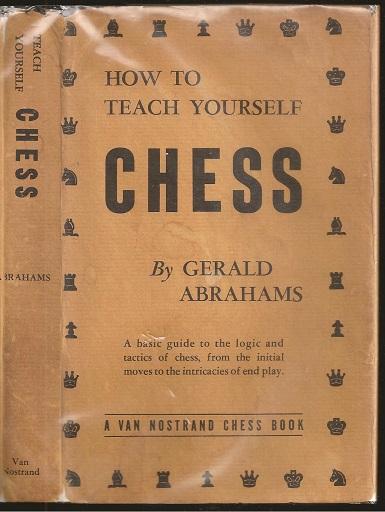
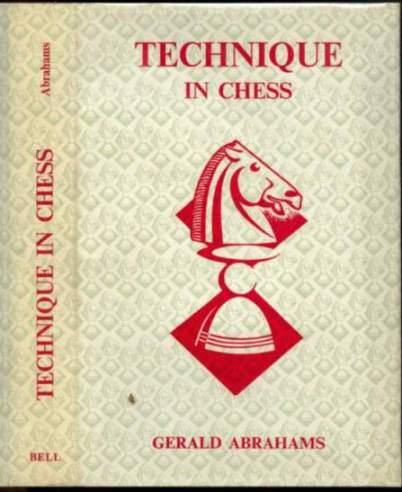
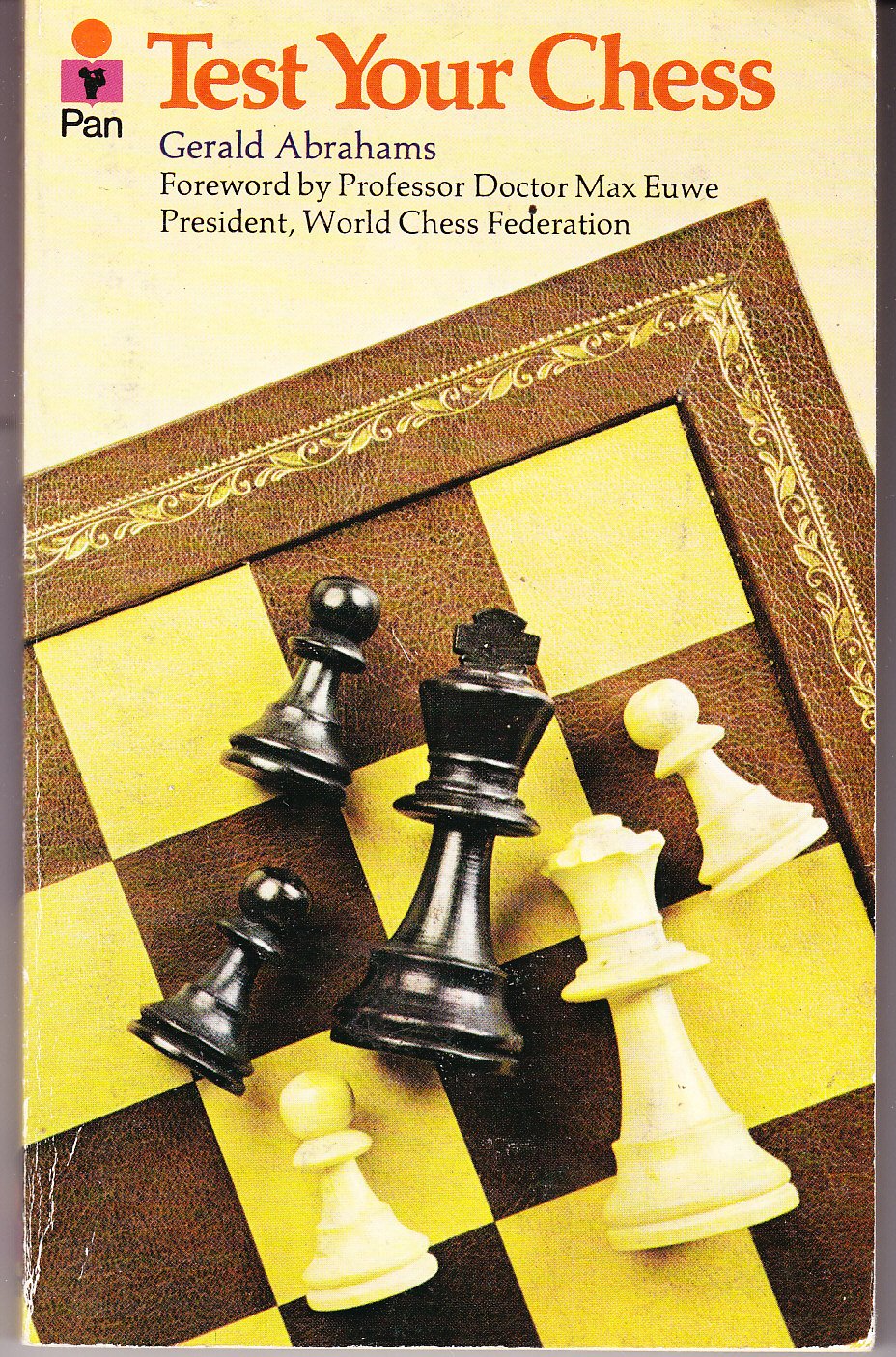
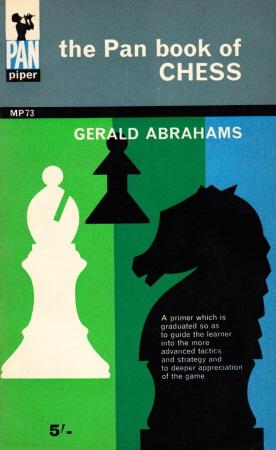
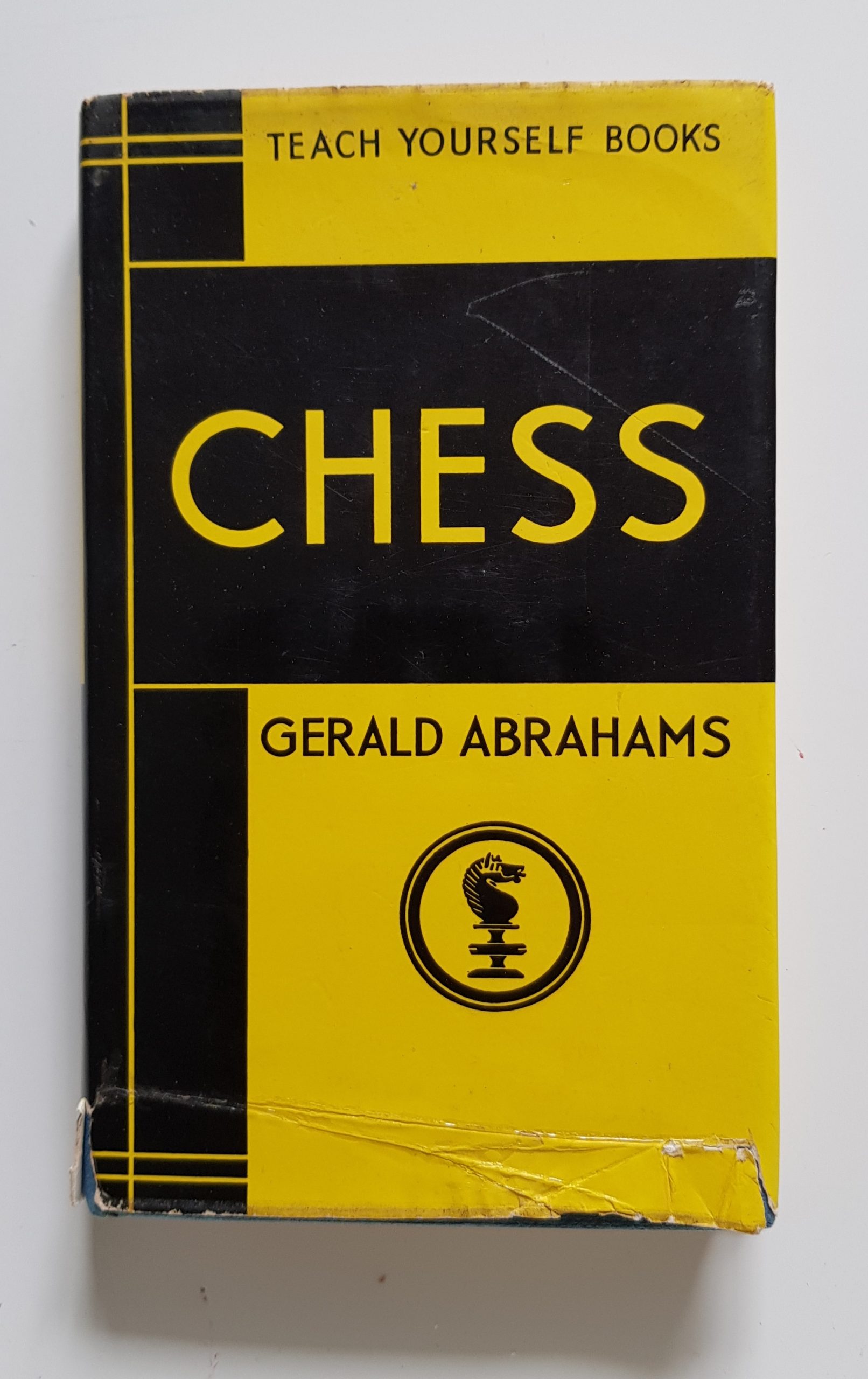
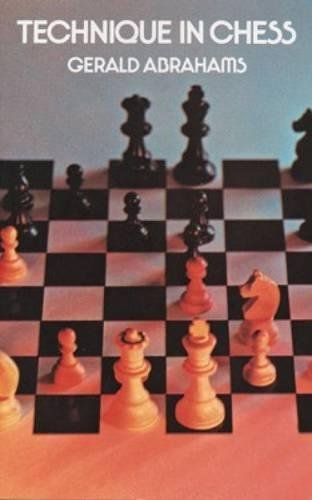
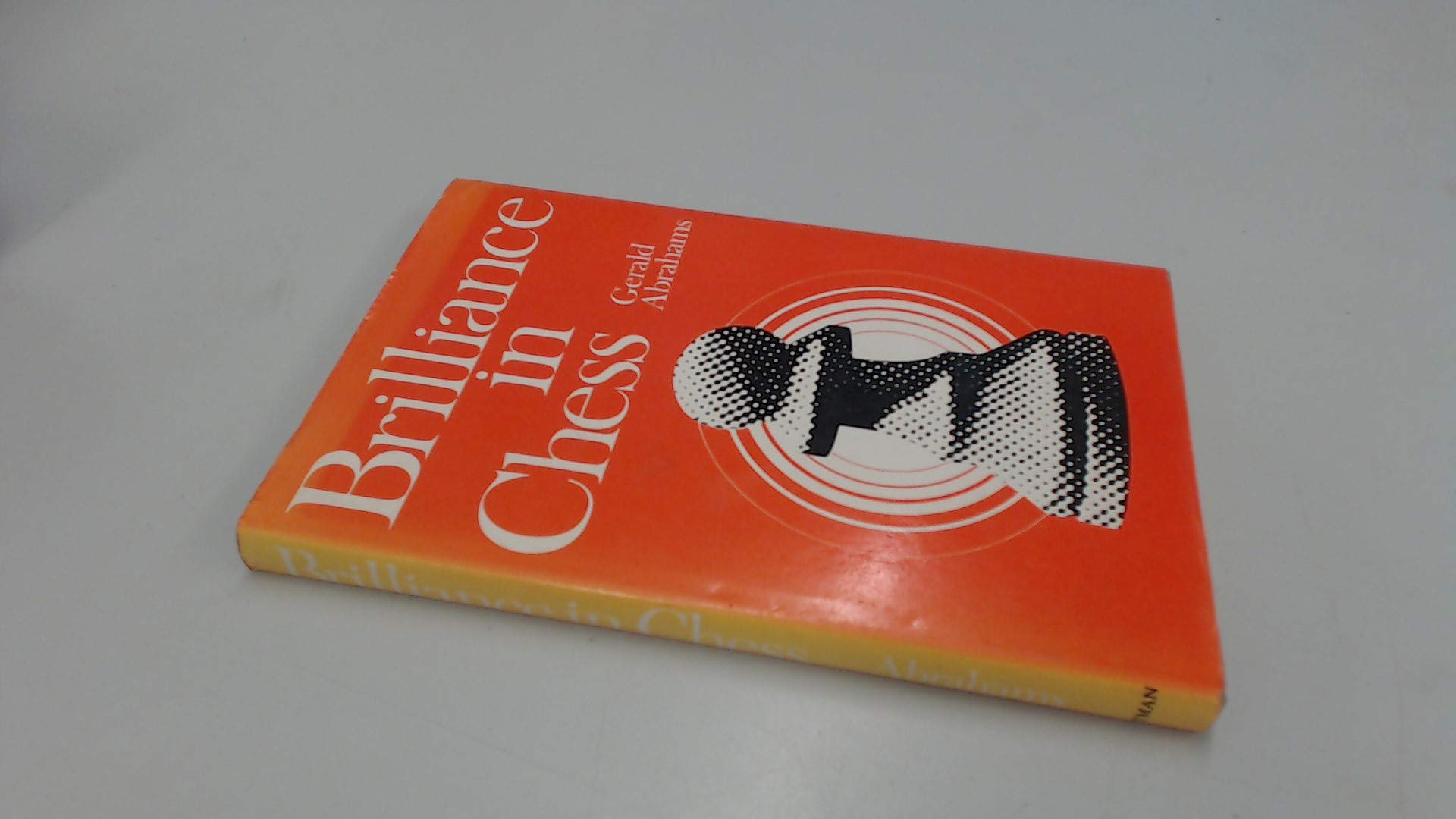
Happy Birthday to Stewart Reuben born this day, March 14th in 1939.
Stewart was born in Stepney, London. His father (SR referred to him as “daddy” in Poker 24/7) was Israel Reuben and his mother was Ann Epstein. Both of his parents was born in England from parents from Minsk, the capital of Belarus.
Stewart resided in Twickenham, Middlesex in recent times and more recently has moved to sheltered housing in between cruises.
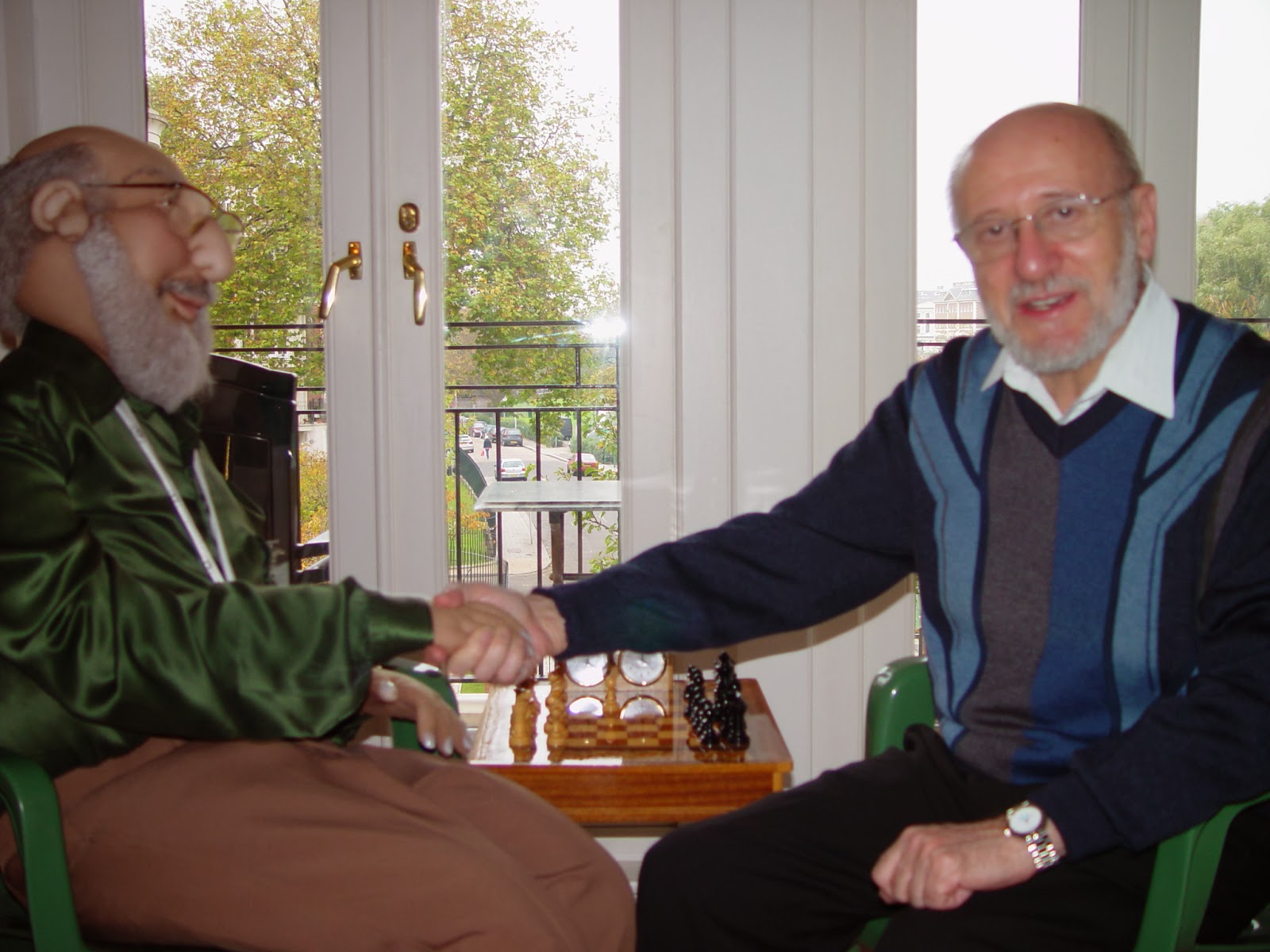
Stewart first joined Islington Chess Club in 1951 at the age of 12.
Stewart’s first holiday by himself aged 17 was in 1956 to play in the British Boy’s Championship in Blackpool when he took up Poker.
Stewart studied chemistry at King’s College, London which he did not enjoy likening it to cooking. (It is usual to refer to refer to organic chemistry as “wet” chemistry).
After graduating Stewart worked for British Oxygen as an industrial chemist and rejoined Islington Chess Club in 1961. At that time Islington was the liveliest club in London. There he knew brothers Ron & Ken Harman and Danny wright. He was also to become great friends with Ron Banwell who left a considerable legacy to English chess.
According to the 1982 tournament book of the Phillips & Drew Kings:
“Stewart was a prime mover in the setting up of the organisation in 1972 which was to grow into the London Chess Association. This was formed in order to reintroduce international chess to London, where there has been no tournament of note since 1948. Since then we have had the Guardian Royal Exchange Masters in the Evening Standard Congress on 1973. Evening Standard Chess Fortnight in 1975, Lloyds Bank Masters since 1977, Lord John Cup 1977, Aaronson Masters 1978 and 1979, the bi-annual Robert Silk, Phillips & Drew 1980, Lewisham since 1981 and the King’s Head International in 1982. ”
His personal catchphrase is “If only I had been consulted earlier”
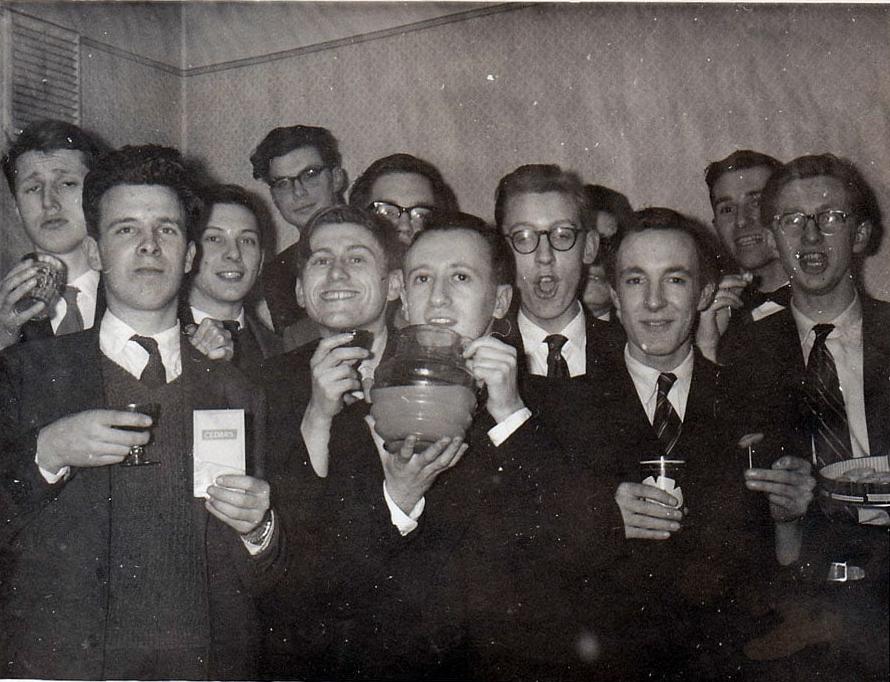
Here is his Wikipedia entry
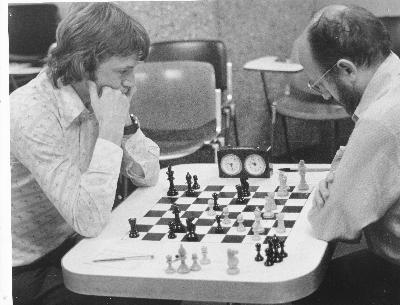
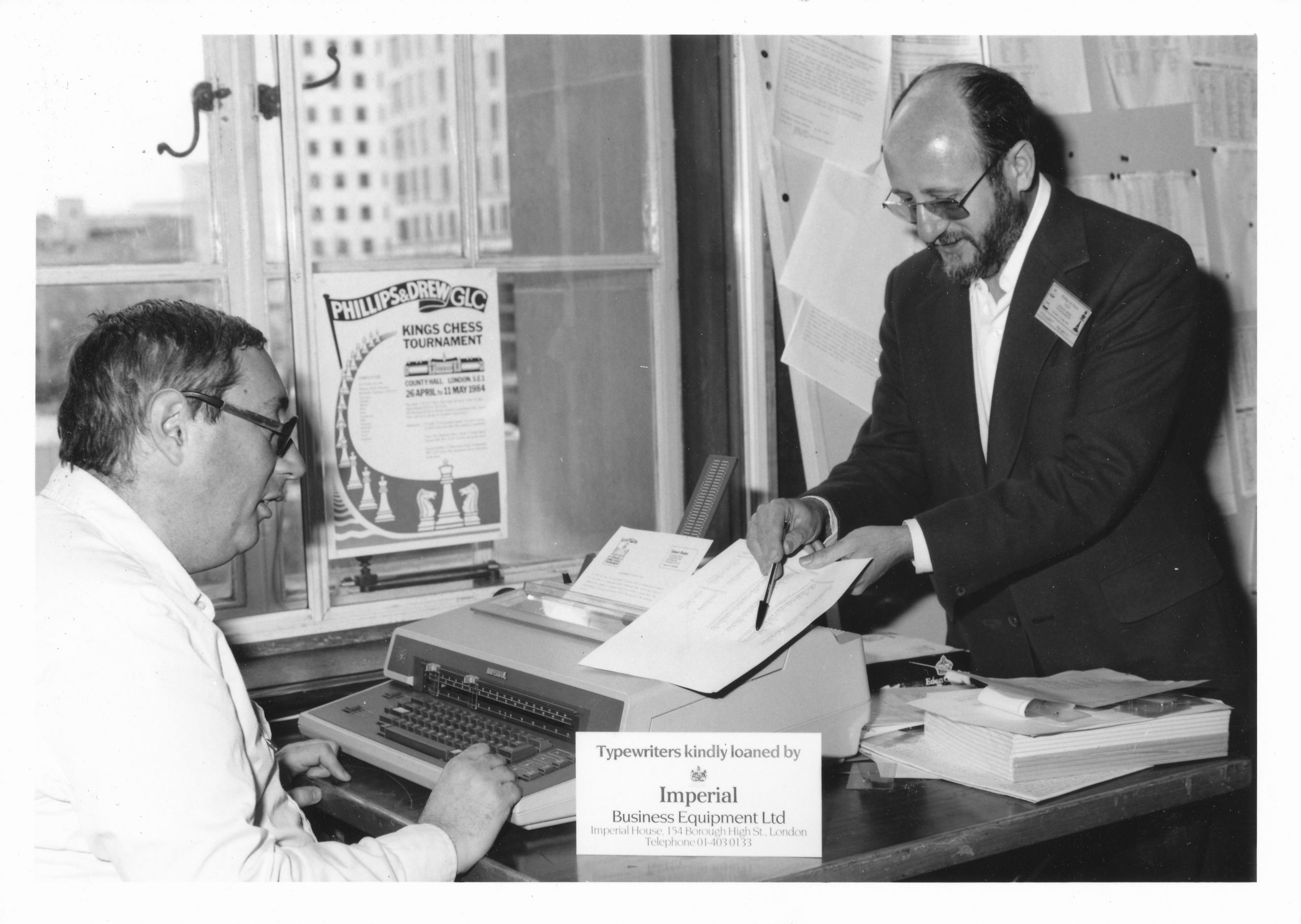

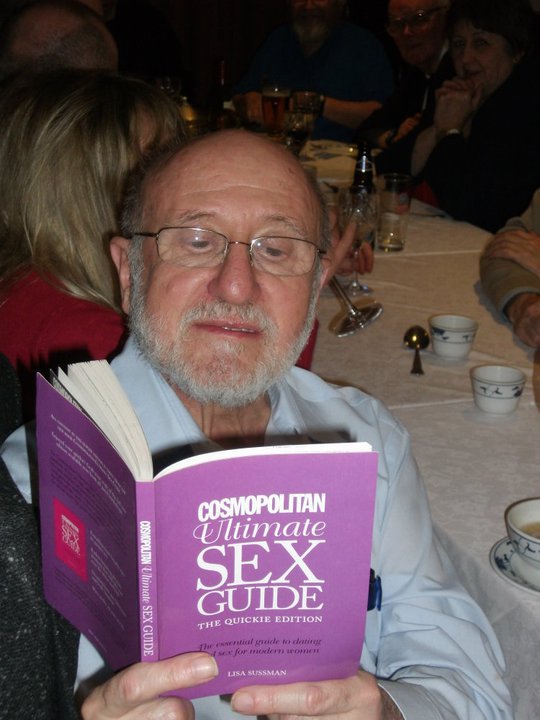
Here are words written about himself from the rear cover of The Chess Organiser’s Handbook :
“Stewart Reuben is internationally recognised as one of the world’s foremost chess organisers and arbiters. He is currently (1997) Chairman of the FIDE Organisers Committee, Secretary of the Rules and Tournament Regulations Committee, member of the Title and Ratings Committee and the Qualification Commission. He is also past Chairman (1996-1999) of the British Chess Federation. He has officiated at and/or organised numerous top-level events, including the World Championship. He holds three FIDE titles : Arbiter, Organiser and Candidate Master”
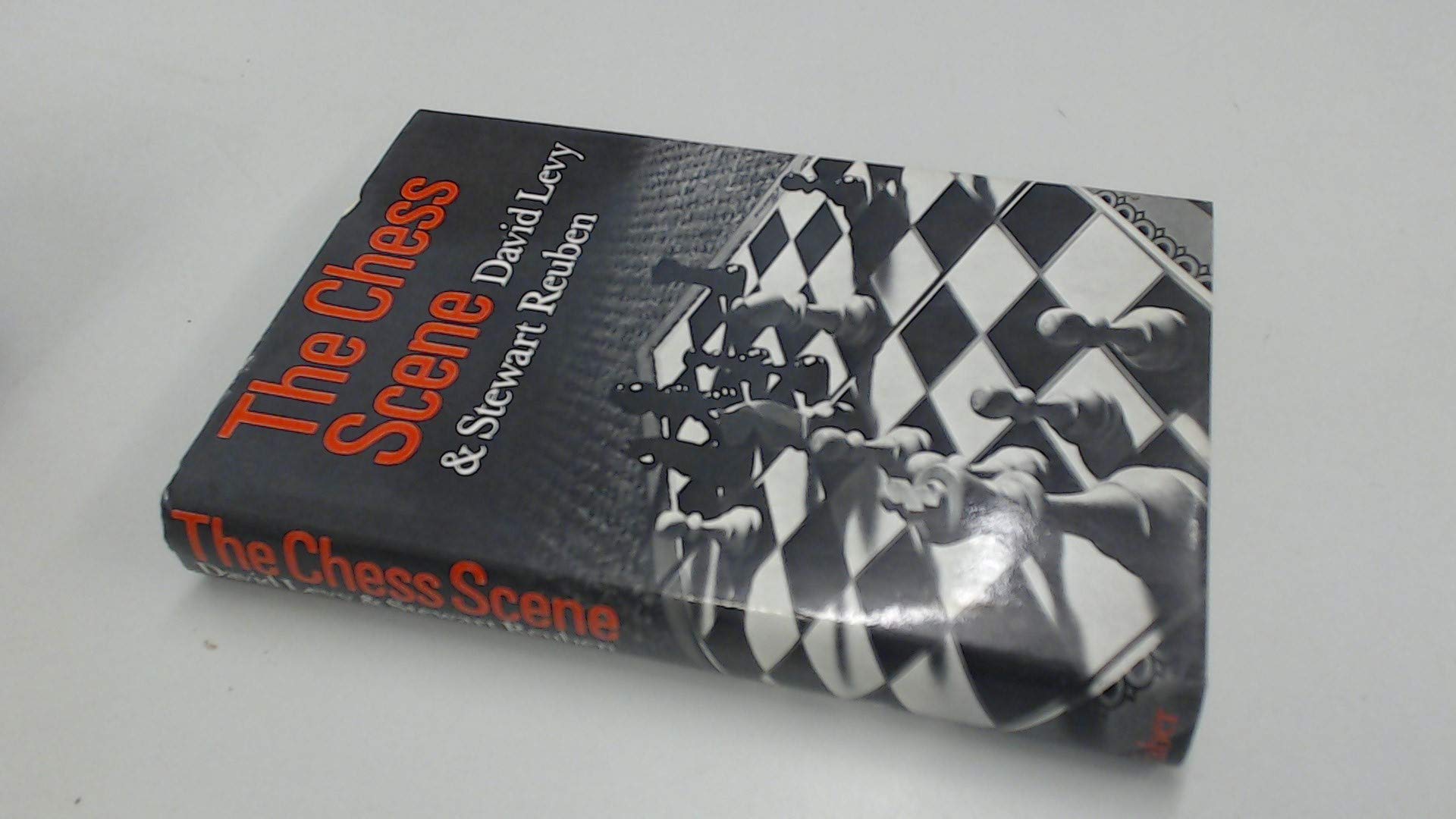
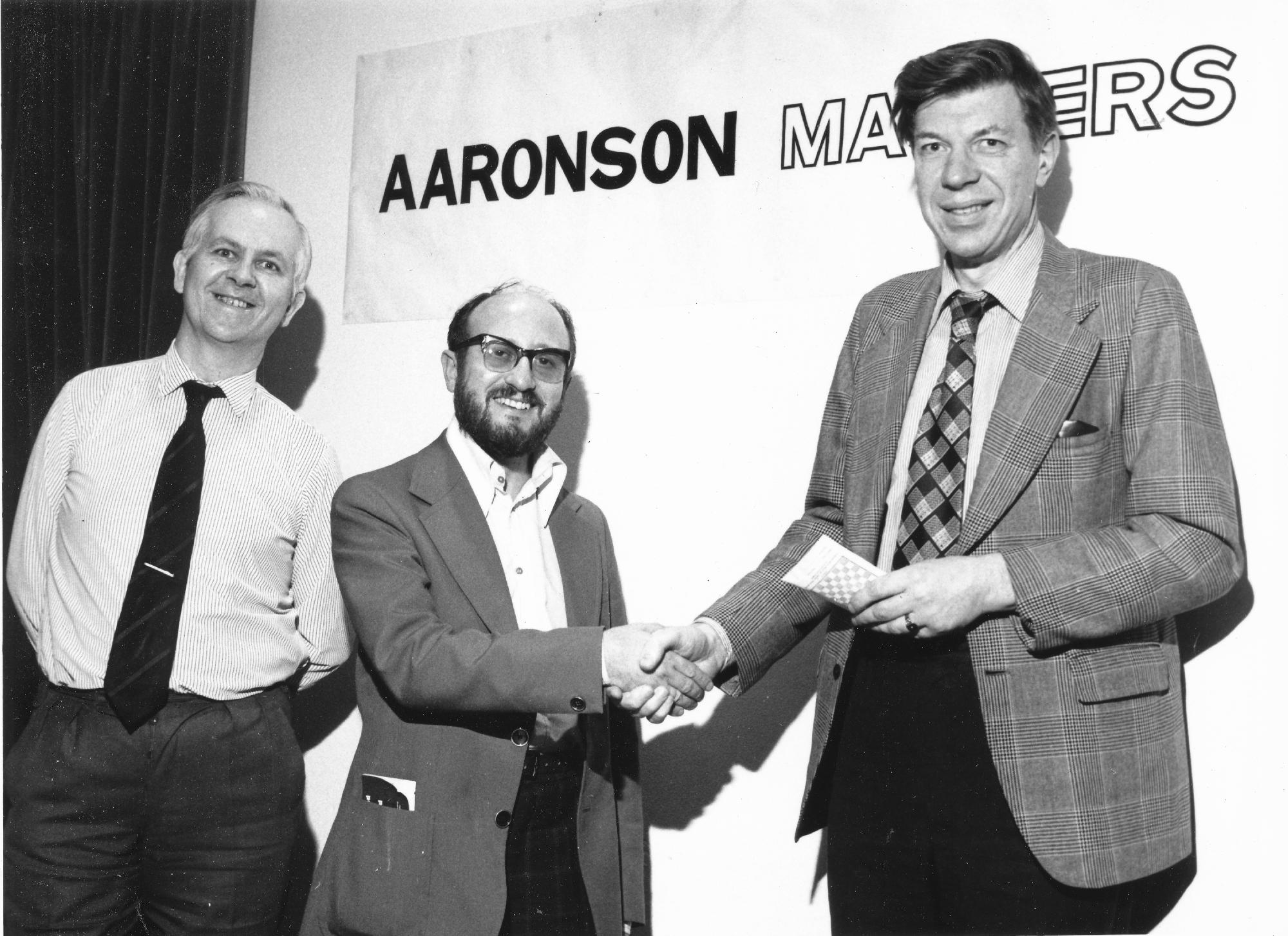

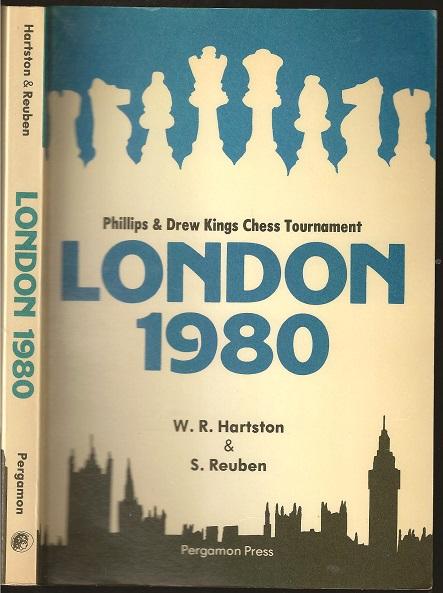

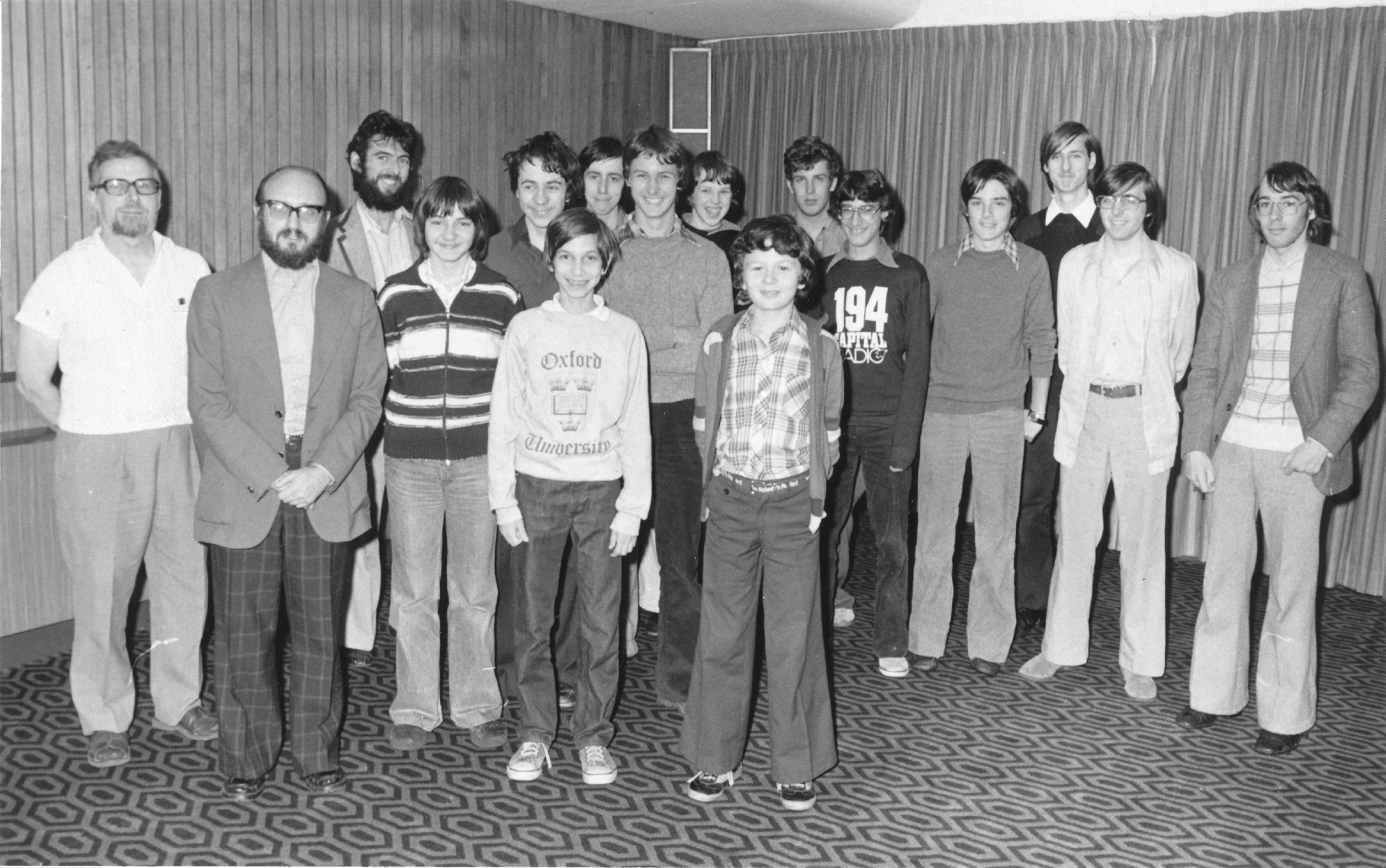
Best wishes to GM Dr. Jonathan Mestel on his birthday
A(ndrew) Jonathan Mestel was born in Cambridge on Wednesday, March 13th 1957. On this day the Presidential Palace in Havana was attacked with the object of killing Fulgencio Batista, the incumbent President.
Jonathan’s parents were Leon and Sylvia Louise Mestel (née Cole) who were married in 1951. Leon was a world-class astronomer and astrophysicist whose PhD supervisor was Fred Hoyle. Jonathan has a brother Ben and sisters Rosie and Leo.
Living in Cambridge he attended Newnham Croft Primary School and at the age six was taught chess by his father Leon. By the age of seven Jonathan was matching his father and not long afterwards he was beating him consistently. East Cheshire Chess Club was his first club and therefore the opportunity to play adults other than his father.
The Mestel family moved to Manchester in around 1967 and Jonathan attended Manchester Grammar School along with chess players Emmanuel Rayner and Ian Watson. Famously he grew a substantial beard and moustache and apparently “they (MGS) disapproved of it” resulting in a ban until the beard was removed. Jonathan duly obliged and returned to school but was sent home once more since he had retained the moustache: “They did not mention the moustache!” we are told. A further ban was resolved when the offending item was also removed.
Jonathan obtained a PhD in mathematics from Trinity College, Cambridge and the associated thesis was entitled “Magnetic Levitation of Liquid Metals”.
Jonathan is Professor of Applied Mathematics at Imperial College London. As well as teaching, his research interests include magnetohydrodynamics and biological fluid dynamics.
In the third quarter of 1982 Jonathan married Anna O’Donovan in Cambridge and they soon settled in the central Cambridge area where they remain to this day. They have a son, David. Sadly, it was reported in The Problemist that Anna passed had away on December 26th, 2022.
Bridge
Jonathan has represented England at bridge joining a group of English players such as Peter Lee and John Cox who also represented their country at bridge. Paul Littlewood, Paul Lamford and Natasha Regan are amongst many others who have combined bridge and chess to a high level . Here is Jonathan’s English Bridge Union page. He remains highly ranked in the bridge world to this day.
Jonathan noted:
I should mention that all my hair fell out for no obvious nor serious reason – neither my bidding nor partner’s dummies are responsible. Few would argue with that last statement.
His earliest recorded appearance in chess databases is from the Rhyl based British Under-14 championship in 1969 where he beat DA Winter. The eventual winner of that event was Jonathan Speelman. Jonathan M. recounts that he shared 3rd place with two others and that the prize allotted to the three of them was a whopping £2 10s to be divided equally. This amounted to 16s 8p each. Since the entry fee was 15s it meant he had cleared a notable profit of 1s and 8 pence!
The following year all British Championships competitors were sent to Coventry and Jonathan and Jonathan shared the Under-16 title whilst Bob Wade won the main event with 8/11.
1971 was no less successful and Jonathan travelled to the location of England’s Eiffel Tower (Blackpool) returning home with the British Under-18 title. Jonathan mentioned that he should have entered the Under-21 event instead.
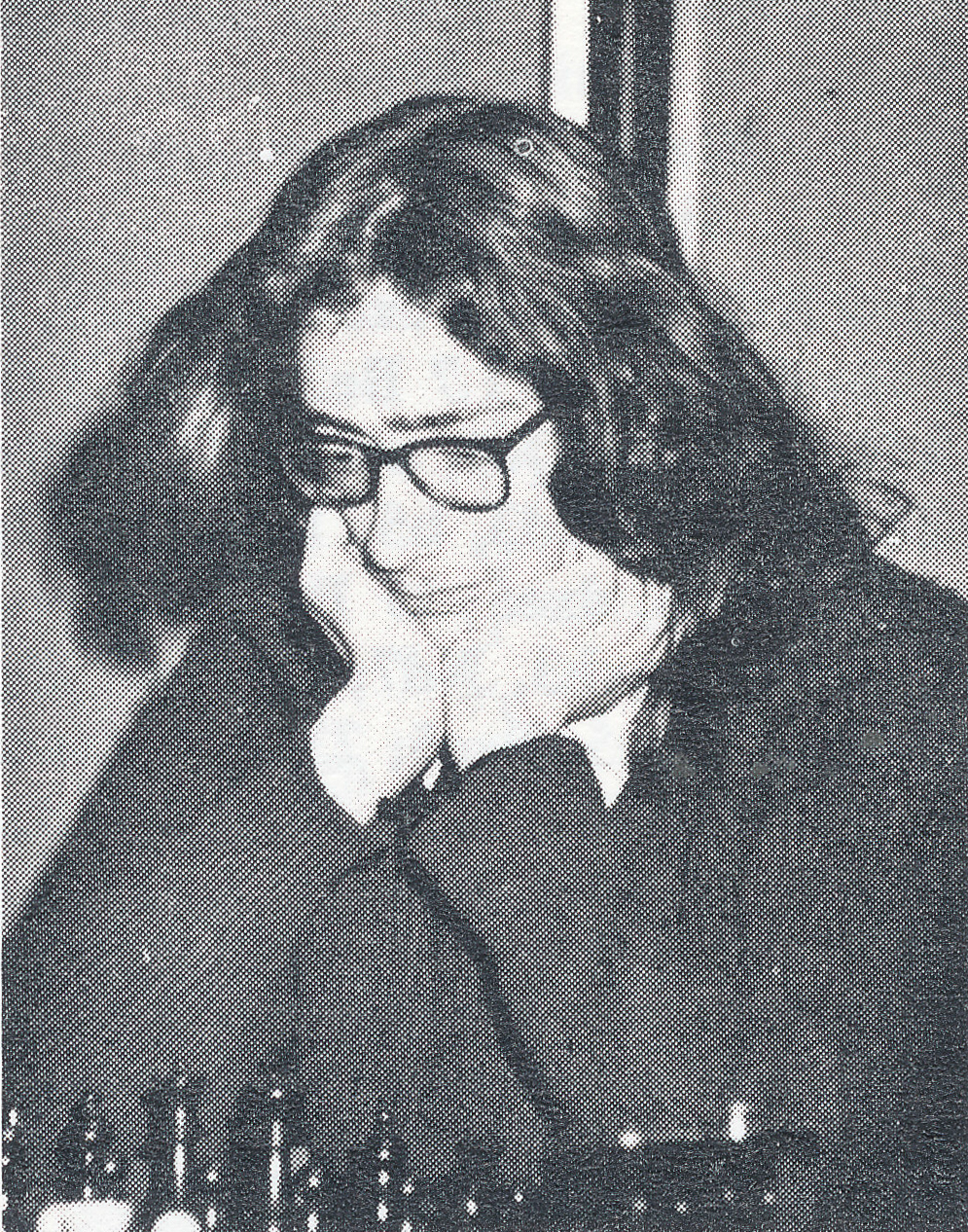
Brighton 1972 was Jonathan’s first appearance in the “main event” having broken the record for the youngest qualifier. This record was later broken by Richard Webb and then by Nigel Short. His final score was a creditable 6.5/11 giving him =5th overall aged 15 years and seven months. In 1972 this was an incredible achievement. Regrettably, these days achievements such as this appear to pass unreported.
At Eastbourne 1973 he was =7th with possibly the best hair cut of anyone:

1974 was a breakthrough year internationally as Jonathan won the (unofficial) World Cadet Championship in Pont Sainte Maxence in southern France. The following year IM David Goodman followed up by winning the same title.
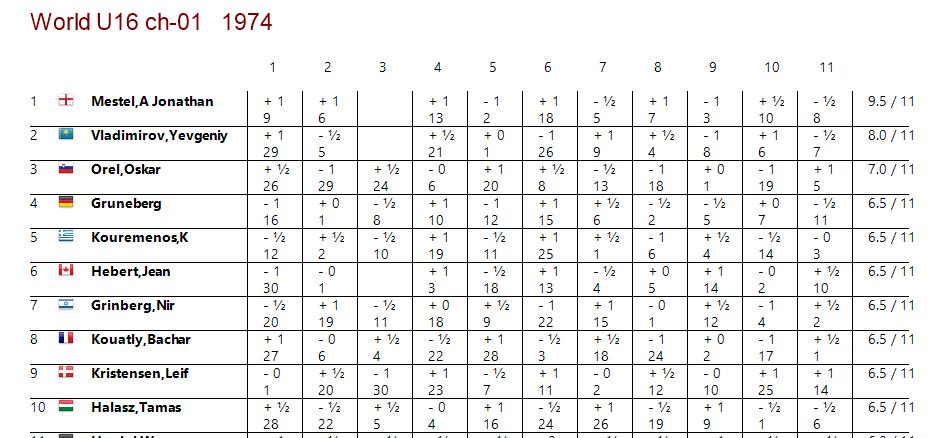
Interestingly travel arrangements for the above event were not so smooth as was the crossing of the English Channel. The hovercraft broke down; Jonathan arrived much later than anticipated and unable to find civilised accommodation leading to an Orwellian style “Down and Out in Paris” sleeping arrangement in a Paris gutter.
At Clacton 1974 Jonathan was one of seven who finished on 7/11, the title going to George Botterill after an all-play-all play-off in Wales.
1975 started well with a bronze medal in Tjentiste (former Yugoslavia now Bosnia Herzegovina) for the World Junior Championship (happening at the same as the British in Morecambe preventing a 1975 British Championship appearance).

1976 brought further success at Portland School, Edgbaston with a first place scoring 8/10 and an IM norm in the Birmingham International tournament:
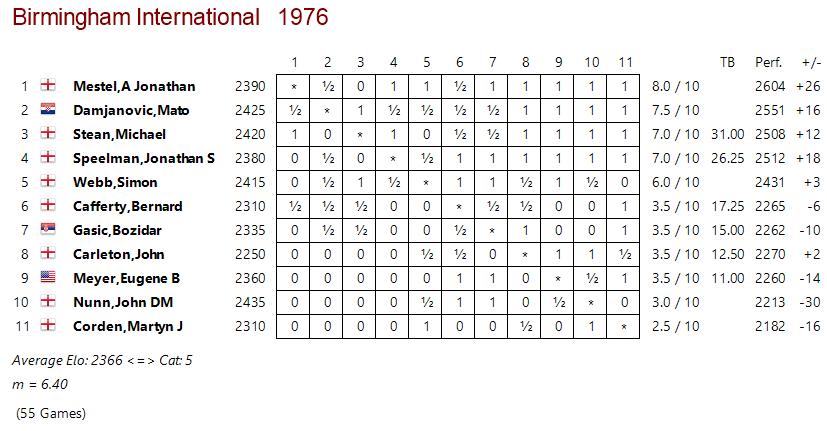
and here is a sparkling game from the 1976 Robert Silk Fellowship Tournament:
Jonathan followed this at the Portsmouth 1976 British Championships with a splendid outright first place with 9.5/11 , the highest score since Malik Mir Sultan Khan in 1933. Also, nine consecutive wins from the starting gun was most definitely a record!

Leonard Barden assessed Mestel’s performance this in the Guardian:
“Jonathan Mestel’s reaction at Portsmouth to become British Champion at age 19, the youngest ever, and with a record series of nine wins, was characteristically low-key. He declined an interview with BBC’s World at One in favour of a continued sojourn on the beach, declined an invitation to the Chorley Congress (where the inducements for him to play were rumoured to include a chauffeured Rolls-Royce from station to town hall, and where the points might well have enabled him to overhaul the leader in the £1,000 Cutty Sark Grand Prix) in favour of a holiday in France, and even ‘declined’ the chance of a record total in the final round when he gifted a pawn in the opening to Whiteley in simple fashion”
Barden went on to praise Mestel as, along with Miles, one of the two young players ‘with genuine promise of ultimately reaching the world super-class.’
1977 led to the International Master title and in 1982 the Grandmaster title. In reality, the GM title should have been awarded two years earlier from Esberg 1979 but more on this FIDE blunder later.
In the 1979 Dataday Chess Diary Harry Golombek OBE wrote this:
“I wrote in last years diary that I doubted whether Jonathan would ever change his variability, adding ‘Probably there will always recur this rise to the heights and fall to lower levels.’
To some extent this is still true. But his play in 1977 and 1978 has shown a greater firmness of purpose and revealed more powers of endurance and stamina than I had realised he possessed earlier on. Thus, for instance, in the last round of the European Team Championship finals at Moscow in 1977, playing the black pieces against the West German master Kestler, he was the last to finish and he defeated his opponent after nearly 12 hours play and some 105 moves.
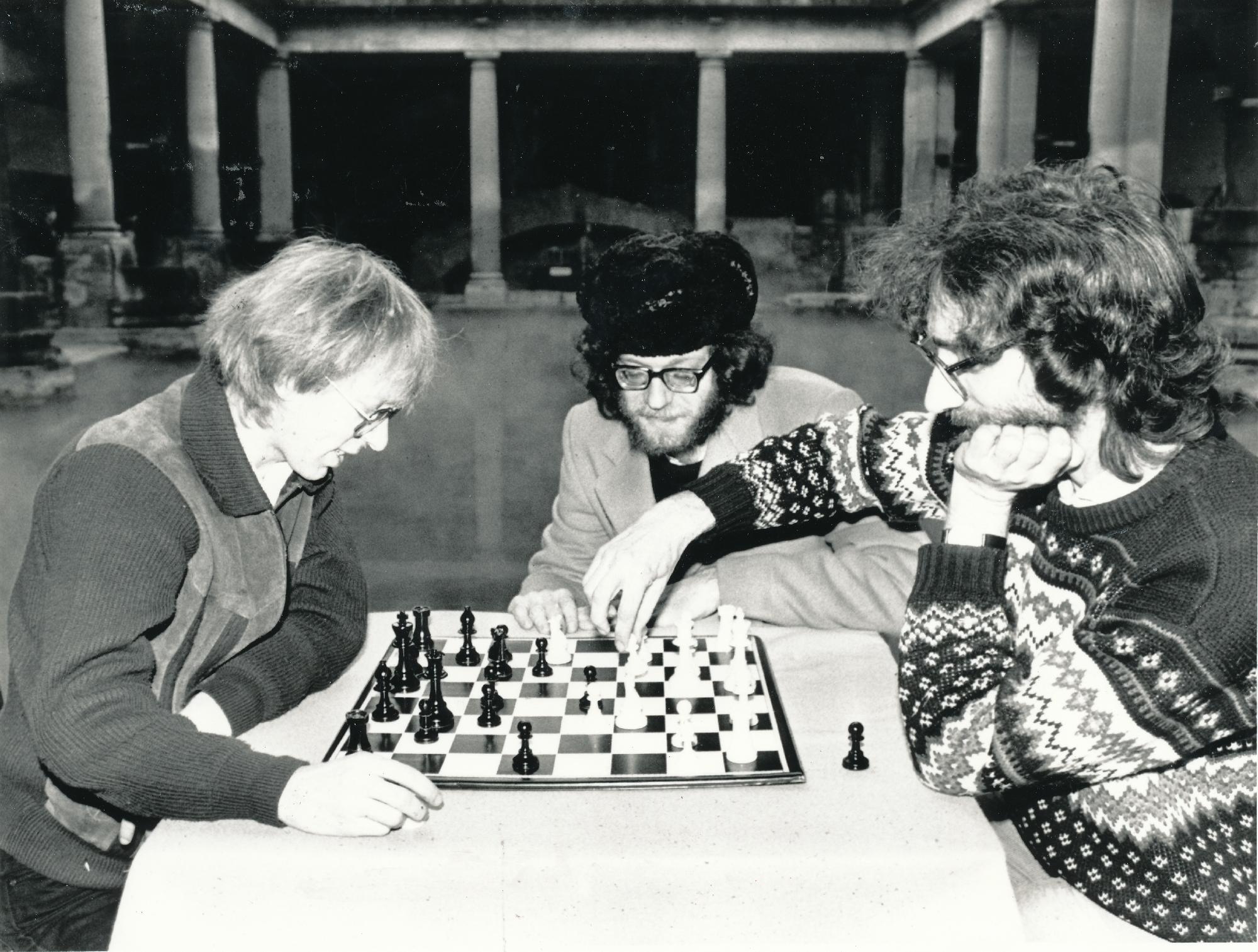
He is one of our players who is nearing the grandmaster title, both in play and, as it were, in figures. At the Lord John Cup Tournament in London, September 1977, he obtained the g.m. norm by coming equal 2nd with Quinteros and Stean below Hort. He did this with a score of 6 when 5.5 would have been sufficient for the norm.
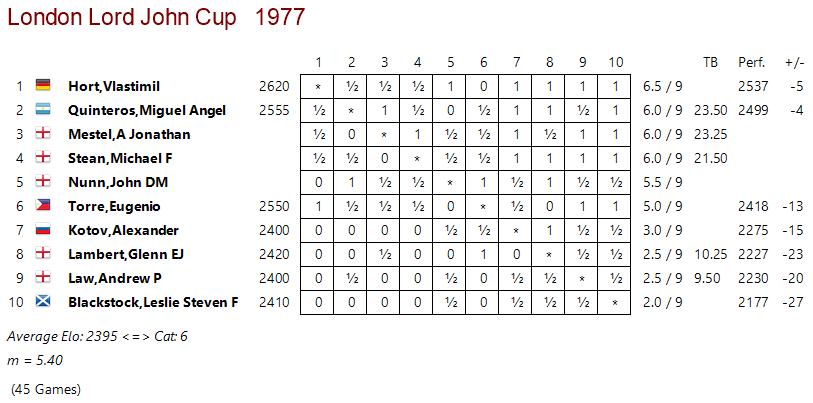
To my mind he is the ideal tournament competitor since he can always be relied upon to delight the onlooker with some fresh and original piece of chess. It is this talent which makes me think there is practically no limit to the heights he may attain as a player.
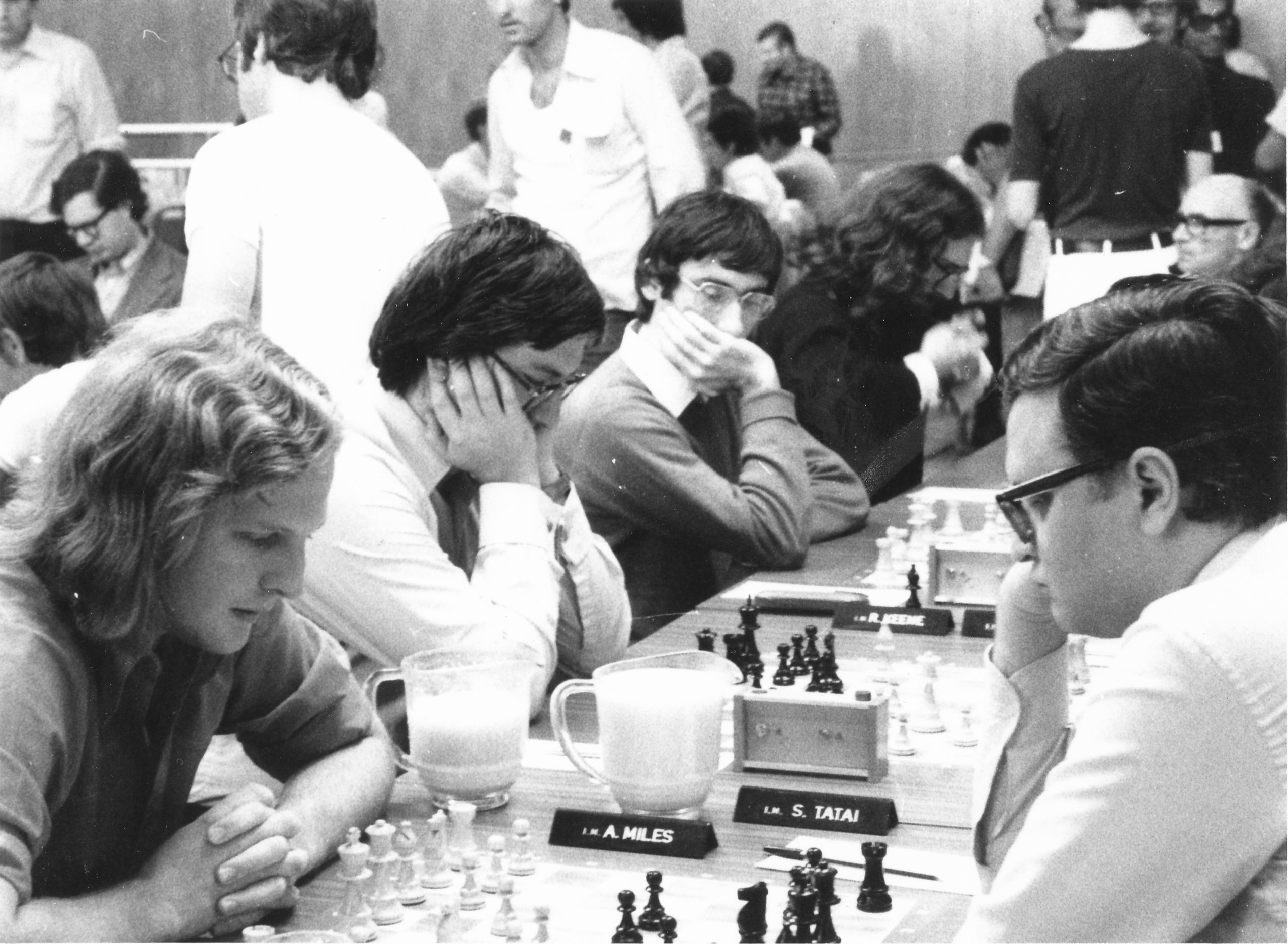
In the following game, played at the European Team Championships at Moscow 1977, Mestel gives signs of a new and mature sureness of purpose, whilst retaining all his incisive and ambitious qualities.
In 1978 Jonathan was part of the English team of Mestel, Speelman Taulbut, Goodman and Jonathan Kinlay that travelled to Mexico and won the World Under-26 Student Team Championships. This was a huge achievement as beating the USSR in a chess team event simply did not happen. It is not clear even that the Russian team were all bona fide students: some looking decidedly unstudent like!

The splendid Aztec calendar trophy you can see Jonathan clutching above was taken back to England and generously donated to Bob Wade who, in turn, wrote in his will that it should be returned to Jonathan. To this day this wonderful trophy proudly lives with Jonathan and Anna in their house in Cambridge.
From British Chess (Pergamon Press, 1983), Botterill, Levy, Rice and Richardson we have this appreciation by George Botterill:
“The tournament at Esbjerg in 1979 was a bitter-sweet experience for Mestel. He won many fine games on the way to sharing first place with the hefty score of 9.5 out of 13.

But the real prize for which he was competing was the final norm that would have completed his qualification for the title of grandmaster. In the last round a draw would have been sufficient, but it was not day for peaceful negotiation since his adversary was also his nearest rival, Vadasz, who needed to win in order to tie for first place.
The nervous strain of having two aims in sight, first place and the coveted norm, told on Mestel who played rather beneath himself to lose. It was some consolation that the following victory over Finland’s leading player was hailed as the best game of the tournament.”
If the previous game gives you the idea that Mestel is especially skilled in the handling of an attacking phalanx of pawns, just take a look at this contribution to England’s bronze-medal result in the 1980 European Team Championship.
It is nice to be able to conclude that since the above was written Mestel’s chess status has changed and the story of his near miss at Esbjerg in 1979 turns out to have a happy ending. His GM title was ratified by the FIDE Congress at Lucerne 1982*.”
*It transpired that the initial norm calculation in 1979 was incorrect and it should have been awarded after all. Better late than never!
Jonathan recounts that on St. George’s Day (April 23rd) 1982 he had an important interview in the morning in Cambridge which went very well followed by round eight of the Phillips and Drew Masters at the GLC in London against Lajos Portisch. Here is that game:
So quite a good day all in all!
From The Oxford Companion to Chess (OUP, second edition, 1996) by Hooper & Whyld:
“English player, British Champion 1976, 1983 and 1988, World Under-18 Champion 1974, International] Grandmaster (1982). In the 1976 British Championship he made a record by winning 9 successive games. Mestel’s opportunities for master play are infrequent – he is a lecturer at a University; he scored perhaps his best at London 1977 when he was second ( +4=4—1) equal with Quinteros and Stean after Hort, and he has played several times in the English Olympiad team since 1976. Mestel also an outstanding solver of chess problems, has represented his country in world team solving championships, and was awarded the title of International Solving Master in 1986”
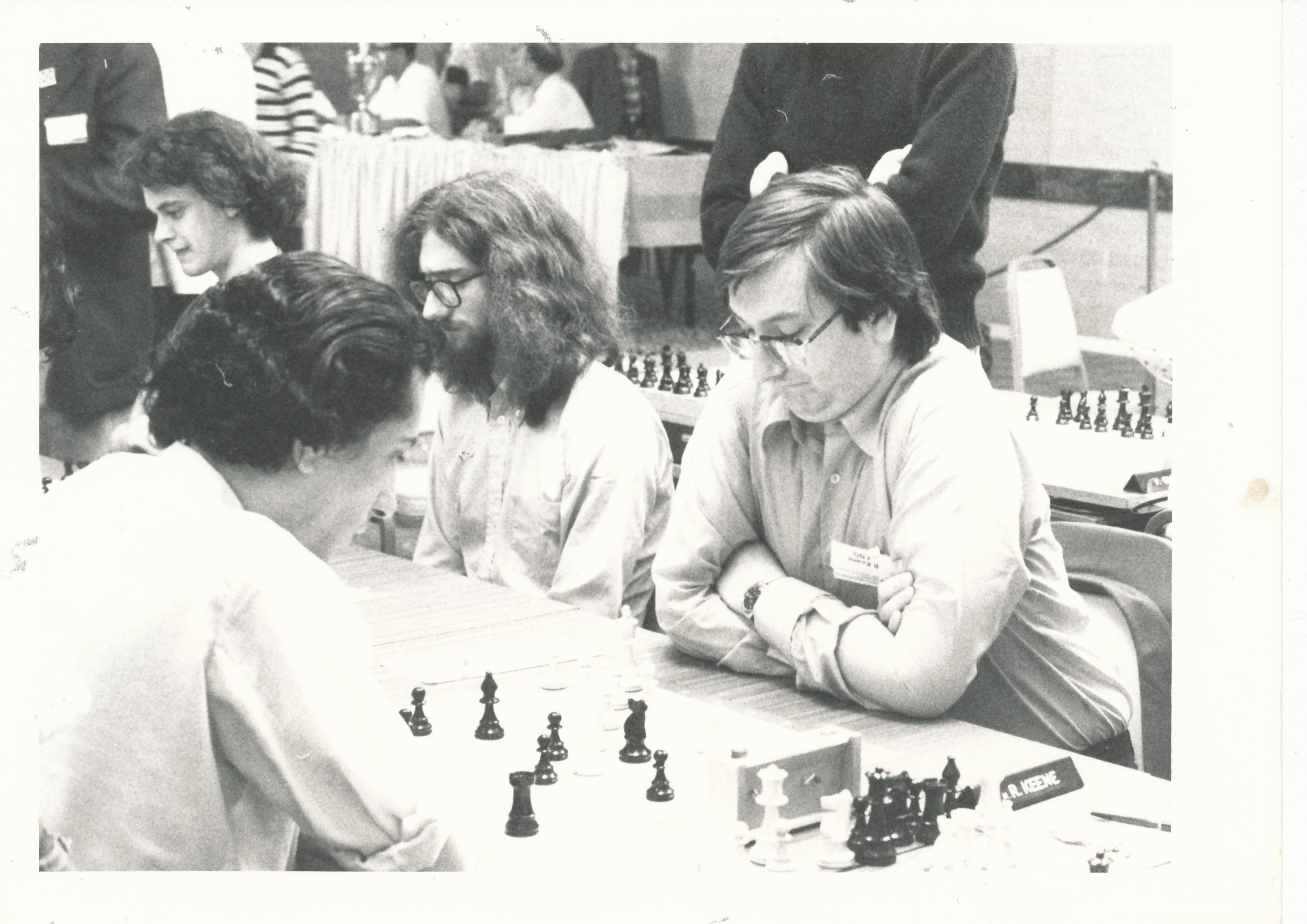
From The Encyclopaedia of Chess (Batsford, 1977), Harry Golombek wrote :
“British Master and British Champion 1976, who was born in Cambridge and packed into the three years 1974-6, in the period of time when he grew from seventeen to nineteen, more chess and more success than most people achieve in a long lifetime.
He first made his presence felt in the international field when he won the cadet championship at Pont Sainte–Maxene in France in 1974. This was an unofficial world under-18 championship and he confirmed this good impression by very nearly winning the British Championship in Clacton in the same year. He figured in a seven-way tie for first place but failed to win the play-off for the title.

The next he gained his first international master norm at the Birmingham international tournament where he finished equal second with Matera (USA) and Miles (England), a point below Matulovic of Yugoslavia whom he beat in their individual game.
He was little disappointing in the World Junior Championship at Tjentiste in Yugoslavia in 1975 in which he came third below the Russian Chekov and the US player Larry Christiansen. It was thought that, talented though he was, Mestel lacked stability and was too variable in his form to achieve the highest honours.
But the next year, 1976, was to show that was quite a false appreciation of his talents and character. First in April he won and international tournament which, if not as strong a the previous Birmingham, was still touch event to win ahead of the Yugoslav Grandmaster Damjanovic.
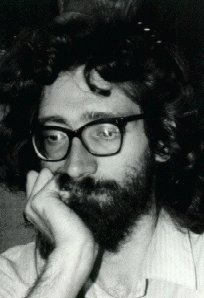
Then came a most remarkable achievement in the British Championship at Portsmouth where he won his first nine games in succession thereby winning the title and establishing a record for the British Championship with his run of victories.”

Mestel has his own named variation in the Giuoco Piano first played in Mestel-Doyle, Dublin 1975:
According to Wikipedia : “Between 1976 and 1988, he was a frequent member of the English Chess Olympiad squad, winning three team medals (two silver and one bronze). In 1984, he earned an individual gold medal for an outstanding (7/9, 78%) performance on his board. Other notable results for English teams occurred in 1978 at the World Student Olympiad in Mexico and at the 1983 European Team Chess Championship in Plovdiv. Both of these events yielded gold-medal winning performances, the latter being exceptional for the highest percentage score (6/7, 85%) on any board. As a player of league chess, he has been a patron of the 4NCL since its earliest days and represented The Gambit ADs in the 2008/9 season.” Jonathan revealed that his most pleasing OTB performance ever was that of Plovdiv.
Jonathan has maintained a long time interest in problems and studies, both solving them and composing them. In 1986 he was awarded the International Master title for solving and in 1997 the International Grandmaster title for solving and in the same year he won the World Chess Solving Championship.

He has represented England in the World Team Solving Championships on many occasions winning in 1986, 1990 (shared with USSR), and then a run of 2005, 2006 and 2007.
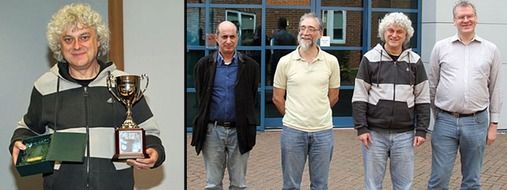
He has played many times in the Lloyds Bank and (now) Winton Capital sponsored British Solving Championships (quite often located at Eton College, Berkshire). He has won the individual title firstly in 1982-83 and then a further 17 times not to mention many times as runner-up.
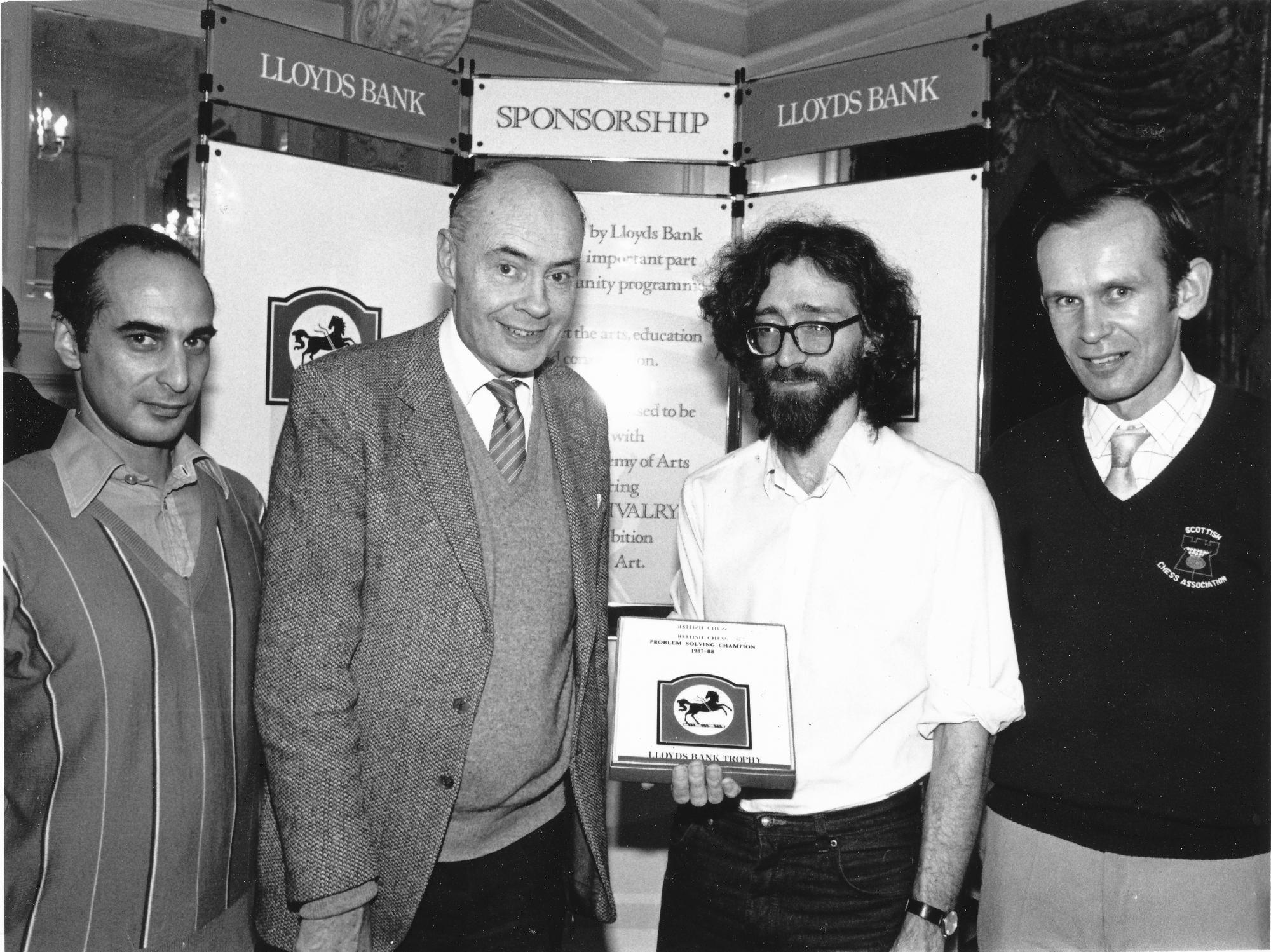
Here are a few examples:
Firstly a prize winning study…
J. Mestel
1.p Niekarker Kruujebitter Ty (tt), 2006
[FEN “8/4pP1k/5q1p/4p3/ppQpP3/3K1pp1/2P5/6R1 w – – 0 1”]
White to Play
and Draw
1.Qe6! [1.Qc8? Qxf7] 1…Qxe6 2.f8Q [2.f8N+? Kh8! (2…Kg8? 3.Nxe6 g2 4.Nxd4 exd4 5.Kxd4) 3.Nxe6 g2] 2…f2 [2…Qa6+ 3.Kd2 Qe2+ 4.Kc1 Qe3+ 5.Kb2] 3.Rxg3 f1Q+ [3…Qa6+ 4.Kd2 f1N+ 5.Kc1 Nxg3 6.Qf7+] 4.Qxf1 Qa6+ 5.c4! bxc3+ [5…dxc3+ 6.Ke3! (6.Kc2? b3+!) 6…Qxf1 7.Rg7+ Kh8 8.Rg8+ Kh7 9.Rg7+ Kxg7] 6.Kc2 Qxf1 7.Rg7+ Kh8 8.Rg8+ Kh7 9.Rg7+ Kxg7 ½-½
and another study:
and another:
and
and
and now a problem:
Jonathan Mestel
British Chess Magazine, 2007
#3, 7+6
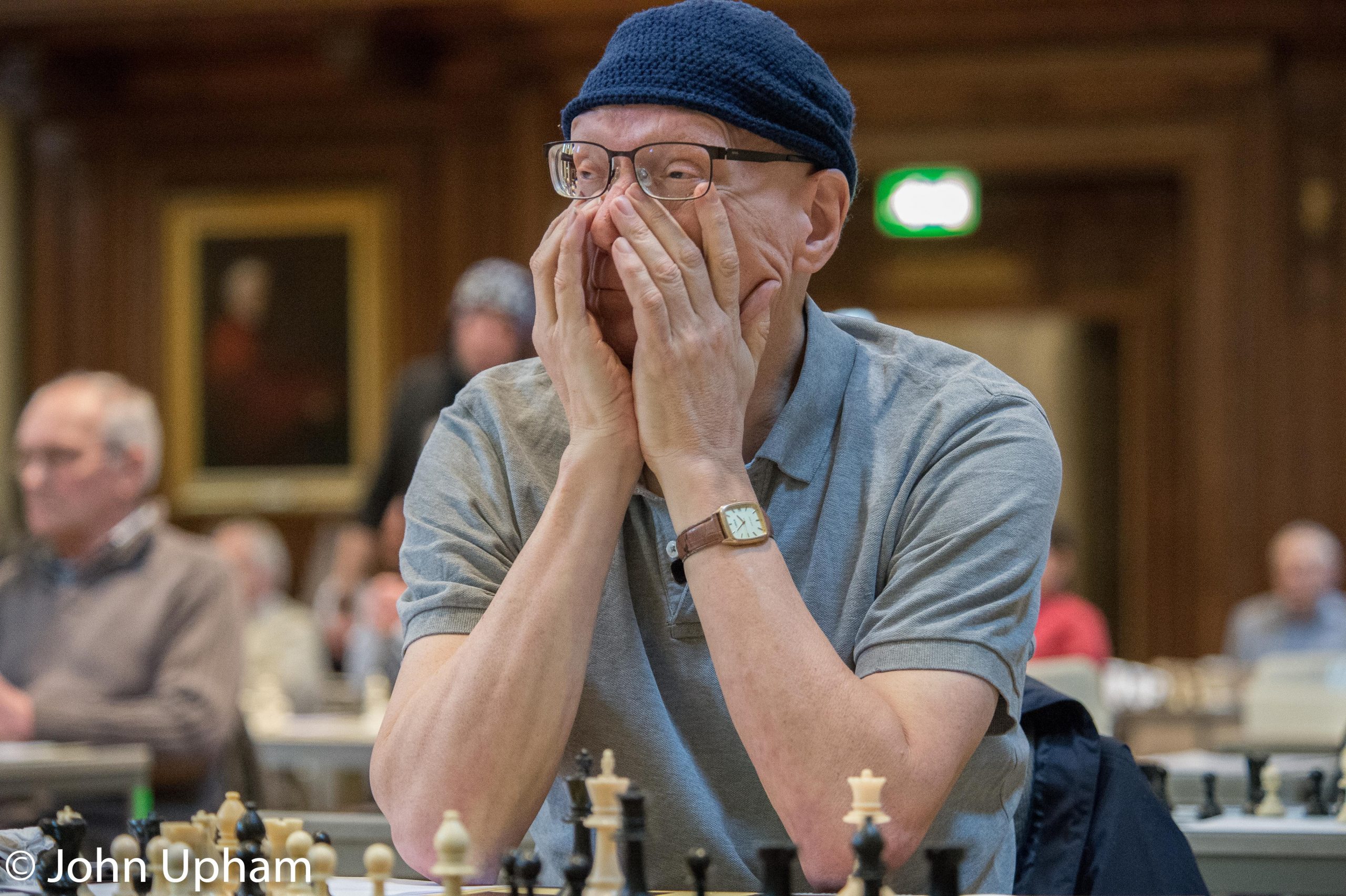
Here is his staff page from Imperial College, London
and his personal page may be found here
A.J.Mestel. Not Your Ordinary Grandmaster. by Neil Blackburn (aka Simaginfan).
Here is his Wikipedia entry
Remembering IM William Fairhurst CBE (21-viii-1903 13-iii-1982)
From The Anglo-Soviet Radio Chess Match by Klein and Winter :
“WA Fairhurst is a North Country man, born in Cheshire in 1903, but he has lived the best part of his life in Scotland. He has been Scottish Champion of many years running, and once captured the British Championship. In his last tournament, London, 1946 he failed to get into the prize list. He is, however, a fine tactician, original in opening play and a dangerous opponent to contend with.
By profession he is a civil engineer and has left his mark as a designer of a special framework for pre-fabricated houses.”

From The Encyclopedia of Chess by Anne Sunnucks :
“International chess master, British Champion in 1937 and Scottish Champion in 1932, 1933, 1934, 1936, 1937, 1938, 1946, 1947, 1948, 1949 and 1962.
Born in Alderney Edge in Cheshire on 21st August 1903, Fairhurst taught himself to play chess from books on the game, when he was 13, when he was 18 he won the Cheshire Championship.
His first major international success was at Scarborough in 1927, where he tied for Yates for 2nd prize, ahead of Bogoljubov, Sir George Thomas, Buerger, among others.
In 1931 he went to live to Scotland, quickly established himself as a leader of Scottish chess and played a major role in agreements between the British Chess Federation and the Scottish Chess Association. In 1932 he gave a blindfold simultaneous display, winning nine games and drawing three, in the Polytechnic Club in Glasgow, and in 1933 he drew match of six games against Eliskases.
Fairhurst has represented Great Britain in matches against Czechoslovakia and the USSR in 1946 and 1947; against the Netherlands in 1937, 1938, 1949 and 1952 and against the USSR in 1954. He also played in the Great Britain v. Australia radio match in 1947. He has represented Scotland in six chess Olympiads, those of 1933, 1956, 1958, 1964, 1966 and 1968.
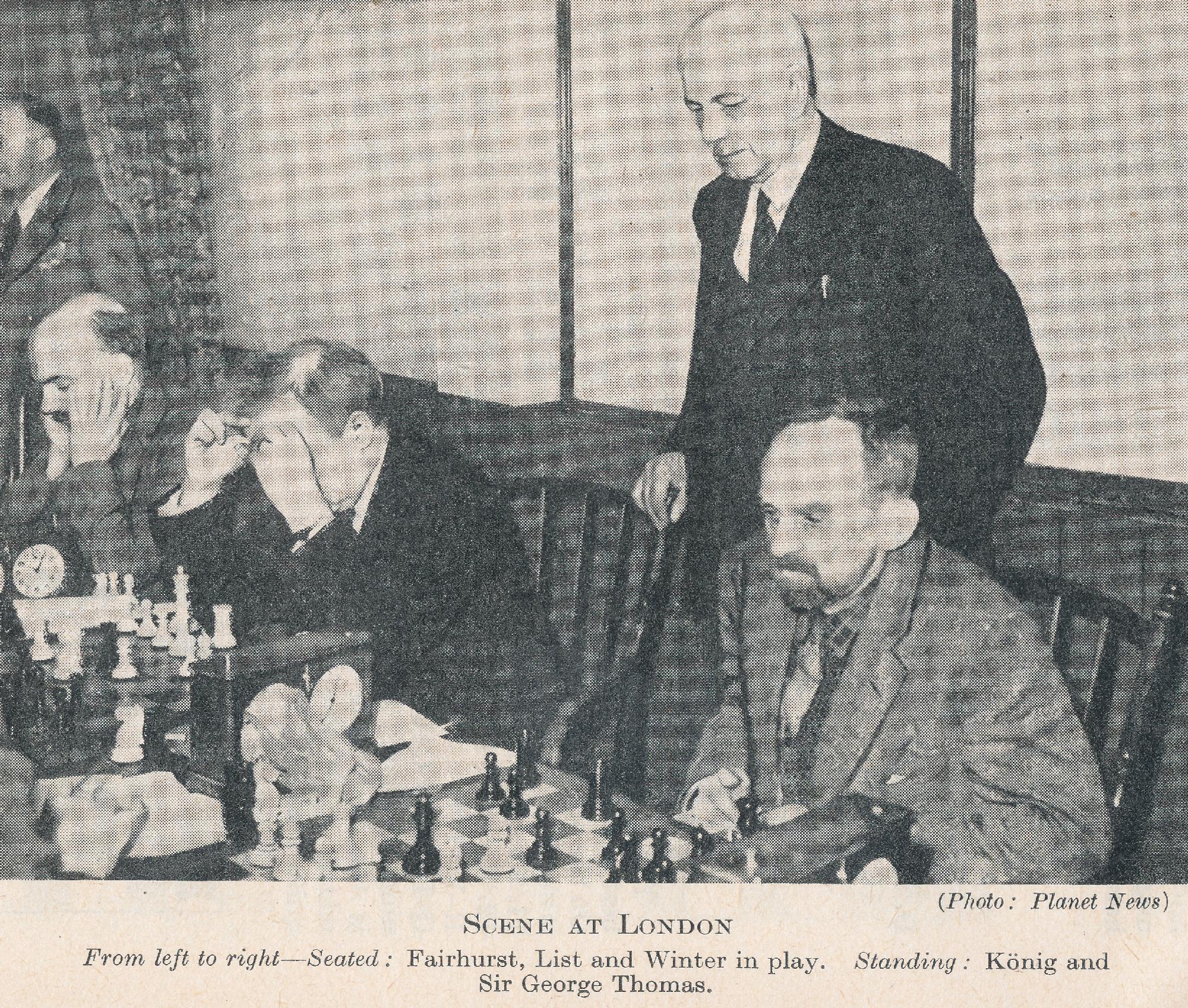
At Hastings in 1947 he came 5th and went through the tournament without losing a game.

Senior partner of a leading firm of engineers and designer of the new bridge over the River Tay at Dundee (the longest river crossing in Europe), Fairhurst was Chairman of the Scottish Branch of the Institute of Structural Engineers and author of Arch Design Simplified. He was also a member of the Royal Fine Art Commission for Scotland.”
In the March issue of CHESS for 1963, (Volume 28, Number 427, pp.147-155) William Winter wrote this:
Fairhurst, British champion in 1937, and umpteen times champion of Scotland is happily still in practice. He is a fine player well equipped in all departments of the game and would undoubtedly have done much more than he did but for the claims of business. Born in Lancashire he is now domiciled in Scotland and has become more Scottish than the Scots themselves. He caused me great trepidation during the Buxton congress in 1950, when he picked me up in his motor-car and drove at high speed down a spiral road with a precipice on one side while he declaimed about the tenets of the extreme wing of Scottish Nationalism. I have myself a good deal of sympathy, with the aspirations of the movement but I am sure this was not the way to make a convert. He still plays for Lancashire in the British Counties’ championship and it was in this competition that I met him at Manchester in 1953. I little thought as I sat down at the board that this was to be the last match-game I would ever play. I am glad to say that it was a good one.;
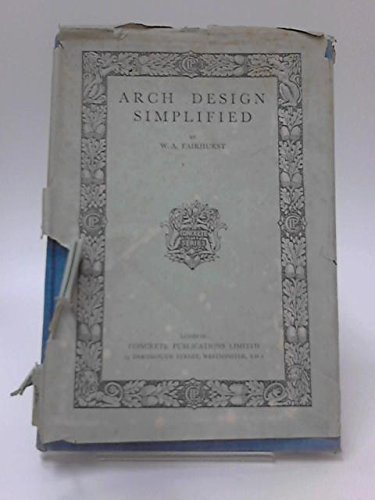
Here are his games
Here is his Wikipedia entry
According to Edward Winter in Chess Notes WAF lived at the following addresses :
Death Anniversary of William Norwood Potter, (27-viii-1840 13-iii-1895)

Here is his Wikipedia entry
From The Oxford Encyclopedia of Chess by Hooper & Whyld :
“Leading English player of the 1870s, barristers clerk. He met strong opposition in only one tournament, London 1876, when he took third place after Blackburne and Zukertort. In match
play he lost to Zukertort in 1875 ( + 2=8—4) and drew with Mason in 1879 ( + 5=11—5). Potter was editor of the London Chess Magazine (1874-6)
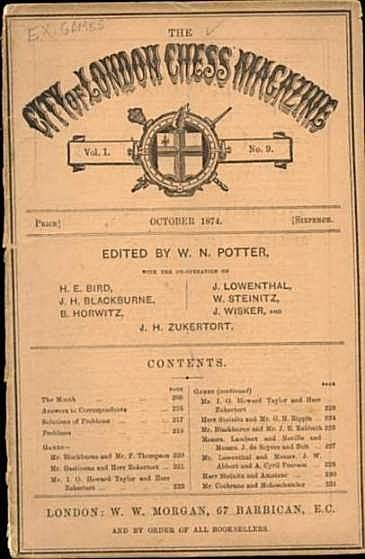
and wrote for the Westminster Papers and Land and Water, contributing annotations of a high standard to all three journals. He played a part in the development of new ideas attributed to Steinitz, with whom he established a firm friendship and to whom he may have shown the ideas of the English School (see schools of chess), in 1872 the London Chess Club, represented by Blackburne, Horwitz, Lowenthal, Potter, Steinitz, and Wisker, began a correspondence match of two games against a Viennese team led by Kolisch for stakes of £100 a side, (The moves were sent by telegraph and confirmed by letter.) Unable to accept the ideas of Potter and Steinitz, the rest of the London team soon withdrew, leaving these two to play on. They won the match. Subsequently Steinitz declared
that ‘modern chess’ began with these two games.

The Potter Variation in the Scotch is :
n.b. The Potter Memorial correspondence tournament was named after Reginald Potter, a past president of the BPCF.
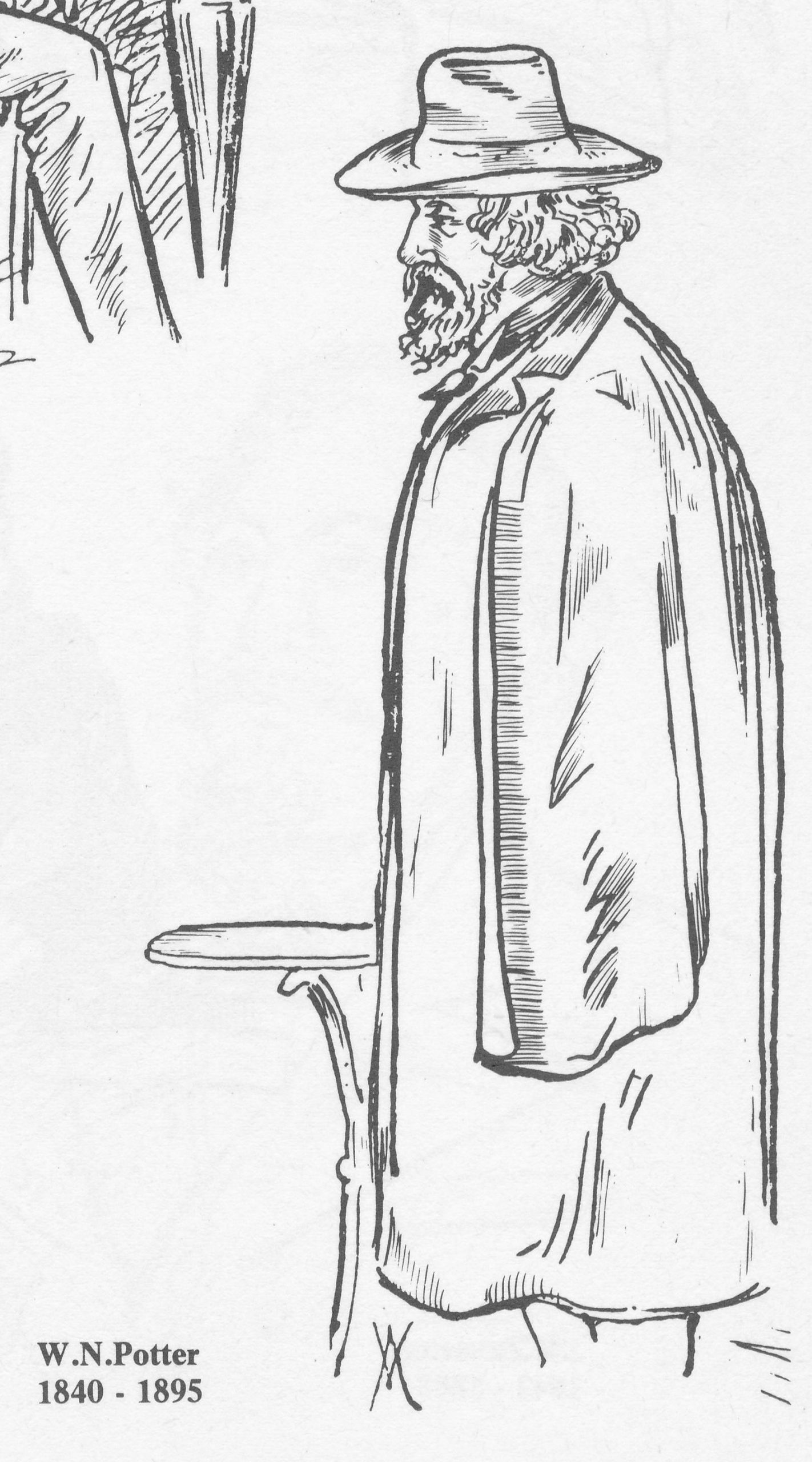
BCN wishes Happy Birthday to IM Peter Graham Large (02-iii-1956)
Peter is a solicitor by day and originates from Bromley in Kent and plays for Epsom Chess Club in the Surrey League.
Peter was Southern Counties (SCCU) champion for the 1979-80, 1987-88 and 1990-91 seasons.
He became an International Master in 1987 and his peak rating (according to ChessBase) was 2370 in July 1986.
Peter is known as Plimsol on Chess.com !

A highlight of Peter’s career was coming 1st= with Paul van der Sterren at the 1980 Philips & Drew IM Tournament with a performance of 2723. Peter shared 1st place with Darryl Johansen with 10/14 at the 1984 London Philips & Drew Knights.
At Hastings 1986/1987 he scored this win over Eduard Gufeld :
and this nice attack against Andrew Muir :
and this exciting game from the 1990 Suffolk Open provided by Tony Rubin :
BCN sends Birthday wishes to GM Stuart Conquest on his birthday this day in 1967.
Stuart was born in Ilford and this is where he spent his early years playing starting at the age of 8.
Since 2011 has taken the role as Director of the Gibraltar International Chess Festival, and has returned to the UK this summer.
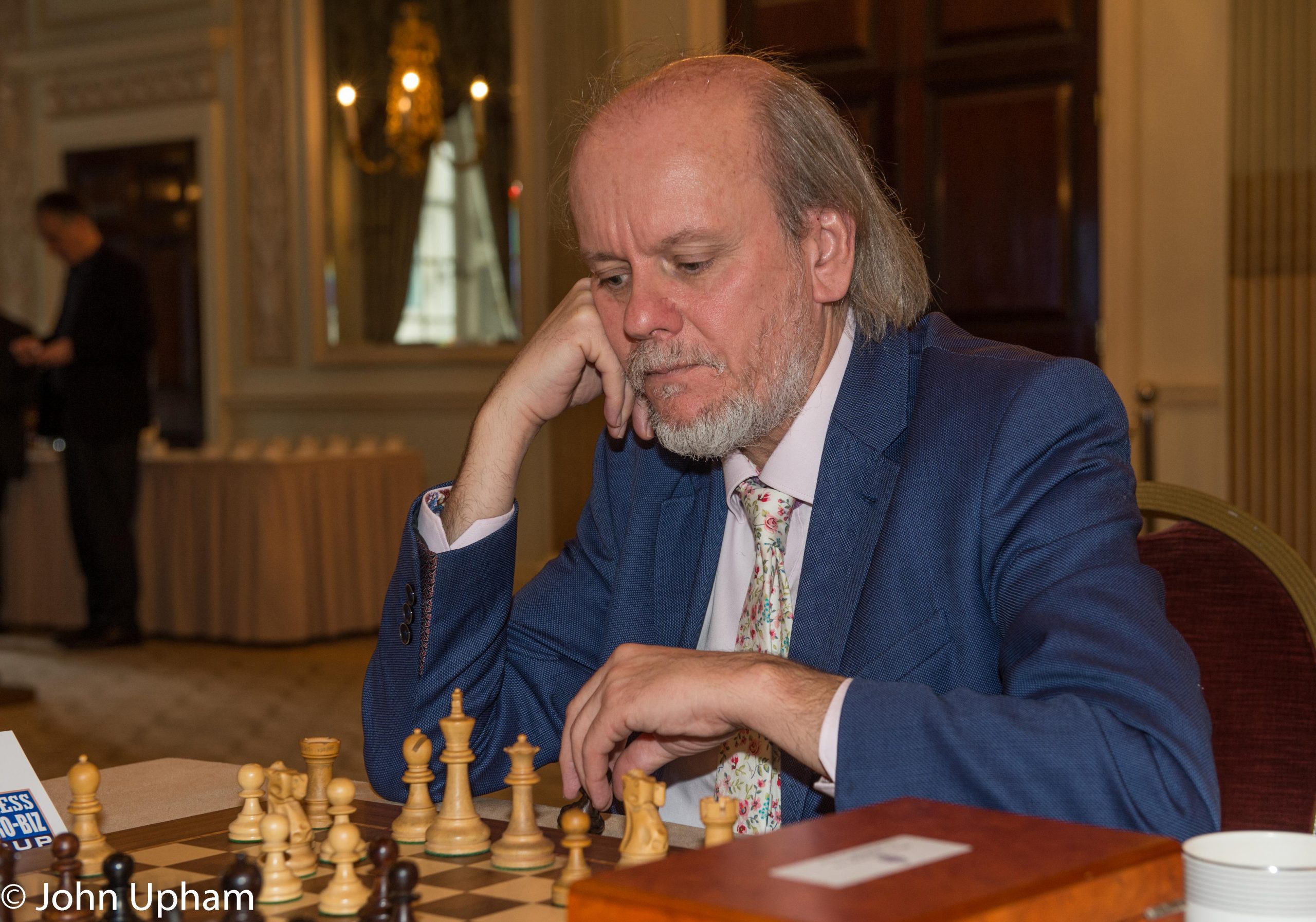
Here is his Wikipedia entry
This was written about Stuart aged 11 prior to the Spassky vs the BCF Junior Squad simultaneous display :
“Hastings. Rating 178. World’s best 11 year old. 100% on board 1 for England, Eumig European children’s cup, 1978.”

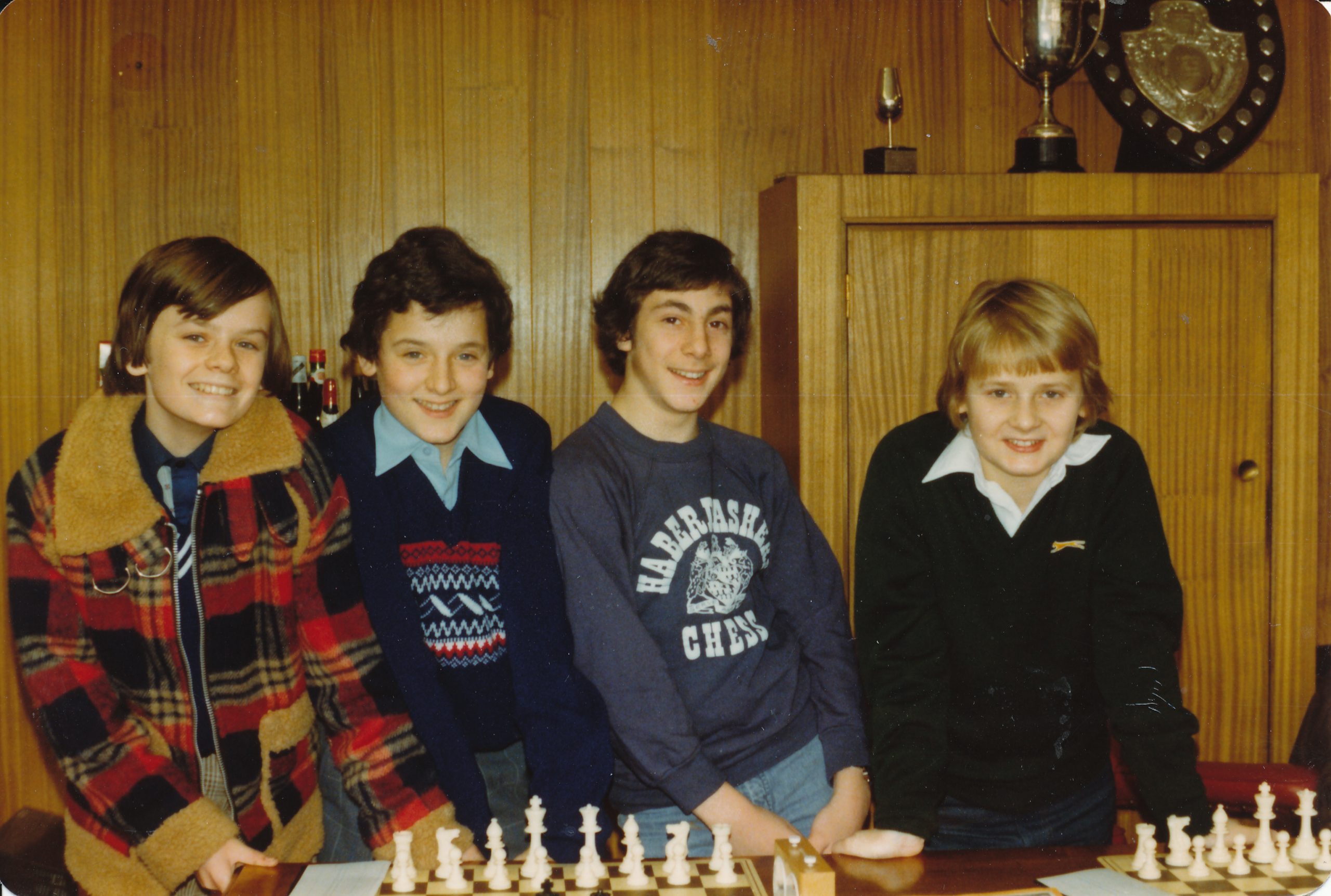
Stuart won the inaugural World Under 16 championship in Embalse, Córdoba, Argentina under the tutelage of IM Čeněk Kottnauer

Birthday of IM Richard John D Tozer (01-iii-1970)
Richard became a FIDE Master in 1989 and an International Master in 1995. According to Felice his peak rating was 2400 in January 1996. He has played for White Rose in the Four Nations Chess League. He currently plays for Cambridge City and maintains a 222 ECF grading.
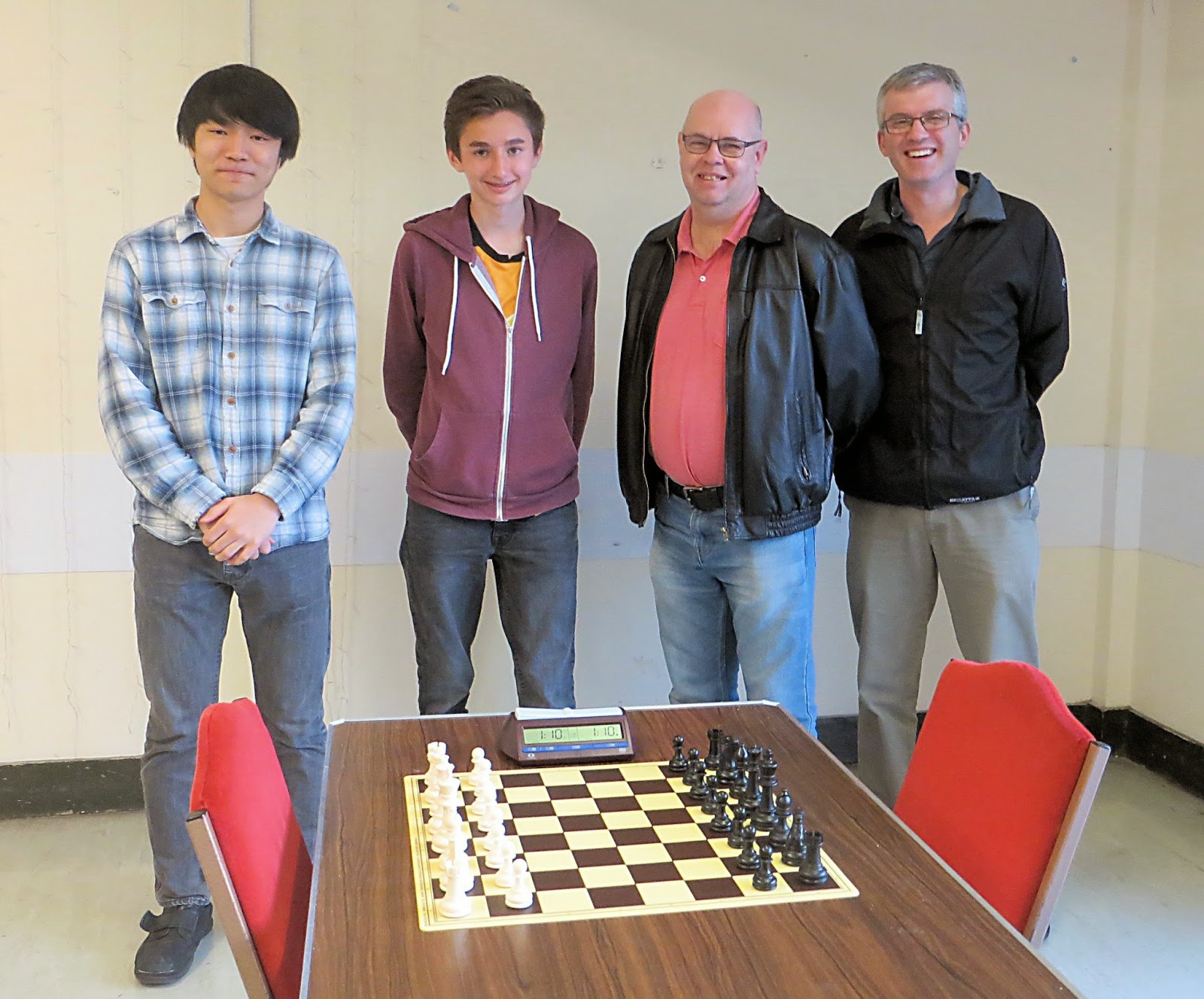
Happy Birthday to IM David Simon Charles Goodman (25-ii-1958)
David became an FM in 1980. His peak rating was 2410 in January 1986.
From Chessgames.com :
“David Simon Charles Goodman was awarded the IM title in 1983. He was World Under 18 Champion in 1975. He played #10 on the English national team in Moscow.
He currently resides in New York City where he is a chess trainer for promising young students.”
Here is his Wikipedia entry


